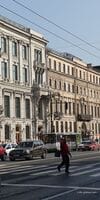Nevsky Prospekt is the main thoroughfare and one of the most popular streets in St. Petersburg.
During its history, Nevsky Prospekt has had several names: Nevskaya Perspektivnaya Street and Bolshaya Nevskaya Perspektiva; since 1781 - Nevsky Prospekt; since 1918 - Prospekt 25-th October, since January 13, 1944, the highway was returned to its historical name-Nevsky Prospekt.
Along with the official names, unofficial street names were also used: the road to the Nevsky Monastery, perspektivnaya road to the Nevsky Monastery, Nevsky Road, Bolshaya, Bolshaya Doroga, etc.
The history of the avenue originates almost in parallel with the creation of St. Petersburg. The avenue was founded in 1710 by Peter I and was formed as the main entrance road to St. Petersburg from the south (from Moscow and Veliky Novgorod).
The newly created street quickly became the main thoroughfare of the city, which, over the course of history, was built up in dense rows of buildings, and also, as the city grew, lengthened-glade after glade, which later formed a segment after segment of the highway.
Initially, the avenue was built up with wooden houses, but two severe fires in 1736 and 1737 destroyed most of the development of the street. After that, according to the decisions of the commission on the St. Petersburg structure, wooden houses on the Nevsky were no longer built.
The government invested money in the improvement and cleanliness of the highway, until, as a result, Nevsky Prospekt became the main road of the city with intensive development.
The final design of Nevsky Prospekt as an avenue-ensemble was formed in the first third of the 19th century. At that time, the masters of high classicism worked.
Subsequently, the buildings along the Nevsky were restored. Already in the modern period (the 1990s), some of the houses on Nevsky Prospekt were dismantled and new buildings were built in their places with a partial or complete reconstruction of the historical facade.
Today, Nevsky Prospekt is one of the main and most visited streets of St. Petersburg, as well as a venue for mass festive events: on New Year's Day, Victory Day (May 9), City Day (May 27) and on other memorable dates-the avenue from Fontanka to Palace Square turns into a pedestrian zone; on September 12, on the Day of St. Prince Alexander Nevsky, a procession takes place along the avenue, from Kazan Cathedral to Alexander Nevsky Square.
The length of Nevsky Prospekt is about 4.5 kilometers. It crosses the historical part of St. Petersburg from the north-west to the south-east-from Alexander Garden (Palace Square and Admiralteiskiy Prospekt) to Alexander Nevsky Square (Alexander Nevsky Lavra).
Nevsky also crosses several significant squares of the city and three reservoirs: the Moika River (on the Green Bridge), the Griboyedov Canal (on the Kazan Bridge) and the Fontanka River (on the Anichkov Bridge).
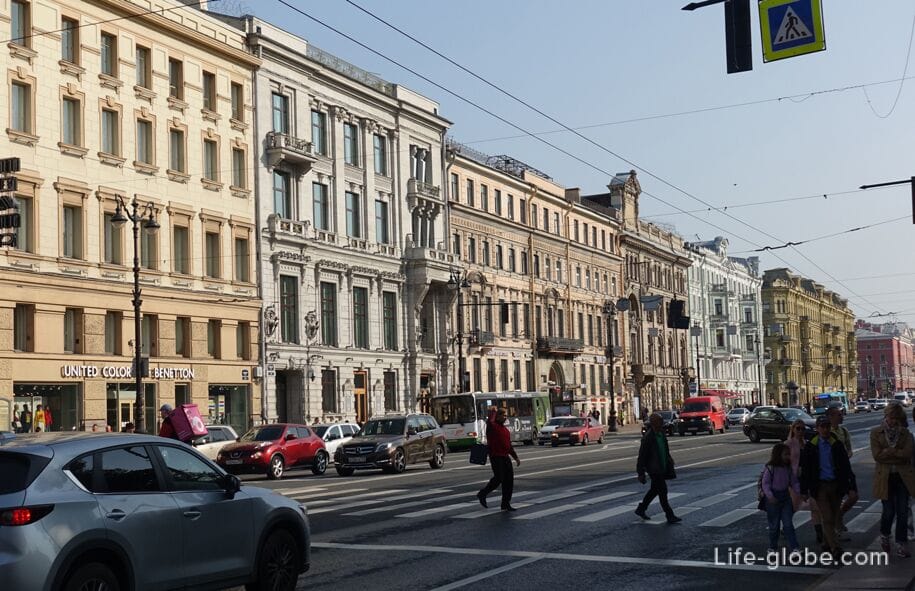
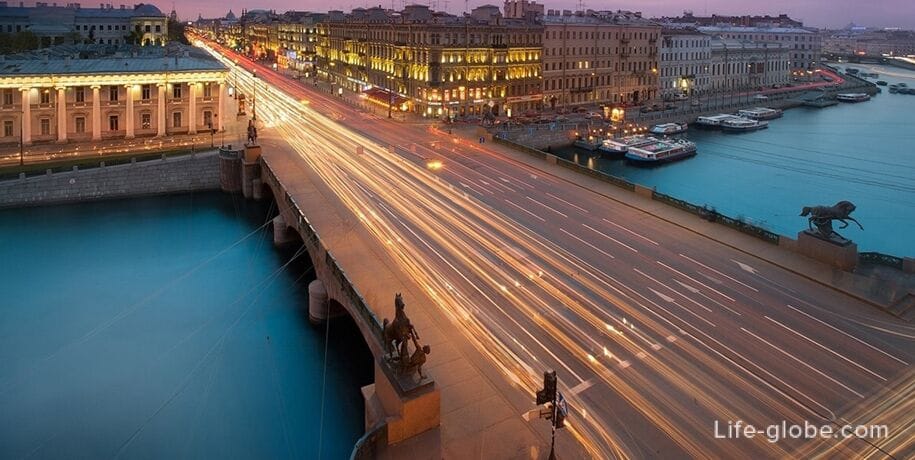
The center of Nevsky Prospekt is formed by a passing road, on both sides of which, along the entire avenue, there are pedestrian sidewalks.
On the eve of the New Year and Christmas, Nevsky Prospekt is decorated with festive illumination - the street becomes one of the most popular in the city for pre - and holiday walks.
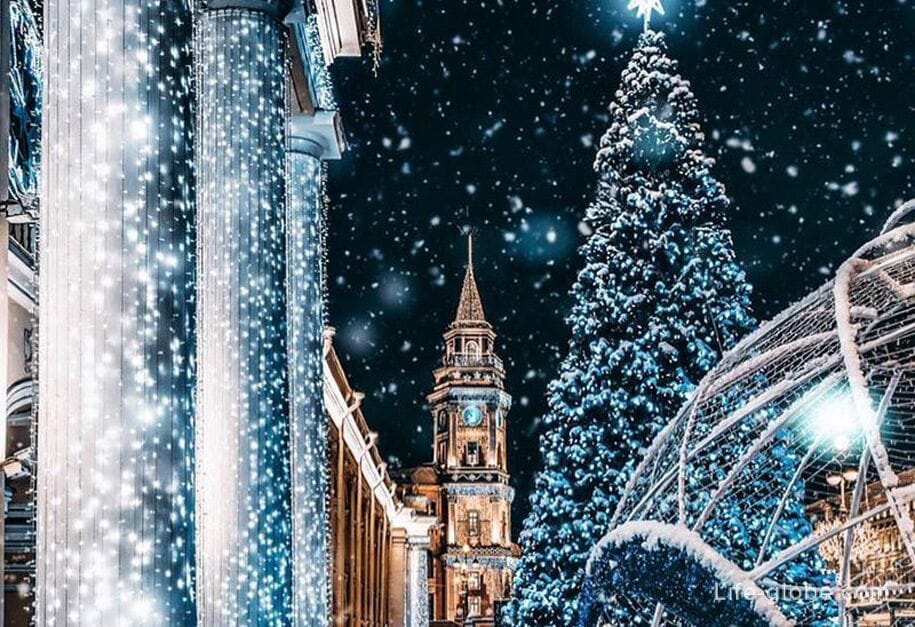
Attractions and objects on Nevsky Prospekt
On Nevsky Prospekt there are 240 facades of buildings that reflect the architectural eras of the Baroque, classicism, eclecticism and Art Nouveau; and, a large part of which are historical monuments, including churches and cathedrals, former palaces and mansions, luxury shops and apartment buildings.
In the buildings on Nevsky Prospekt today there are residential apartments, museums, theaters, other cultural institutions, numerous shops, cafes, restaurants and accommodation facilities (hotels and apartments)
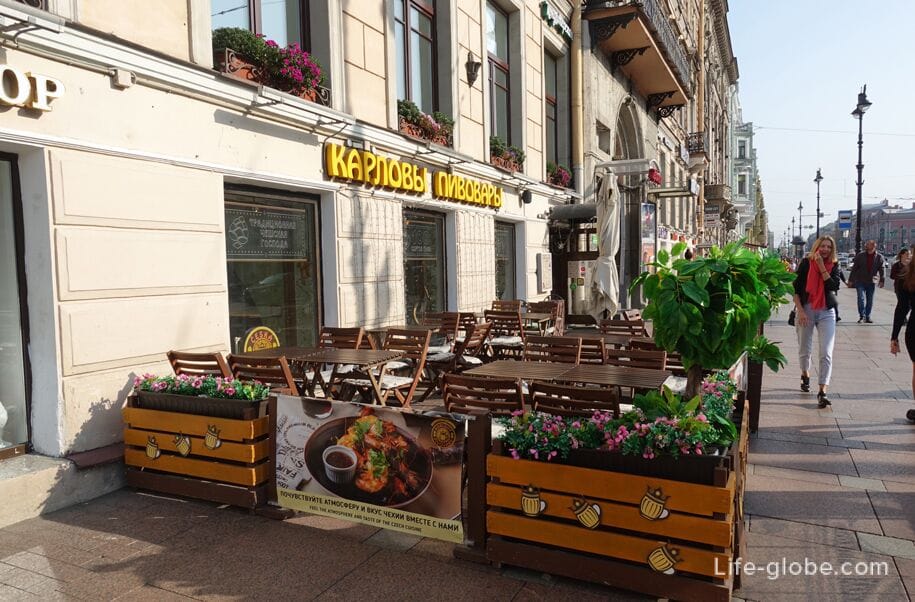
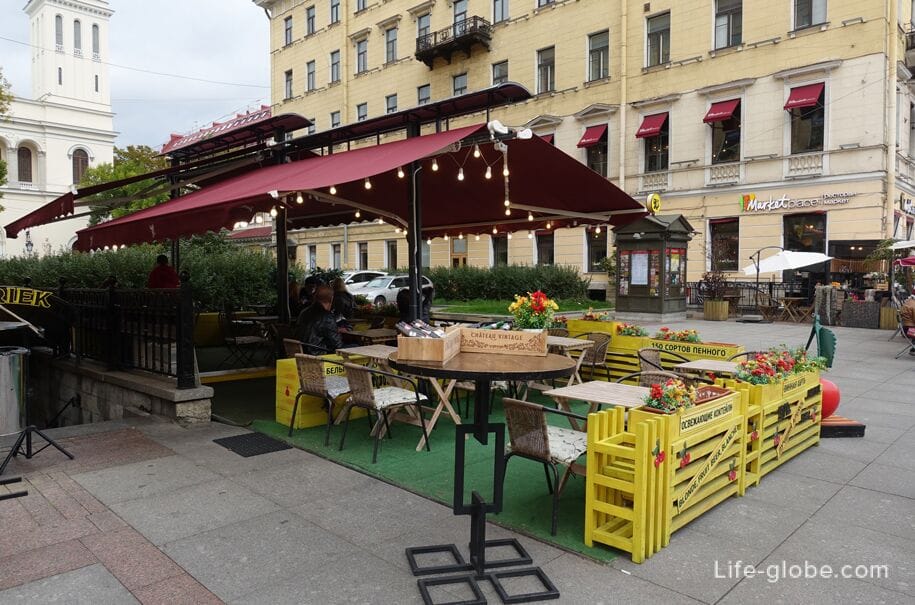
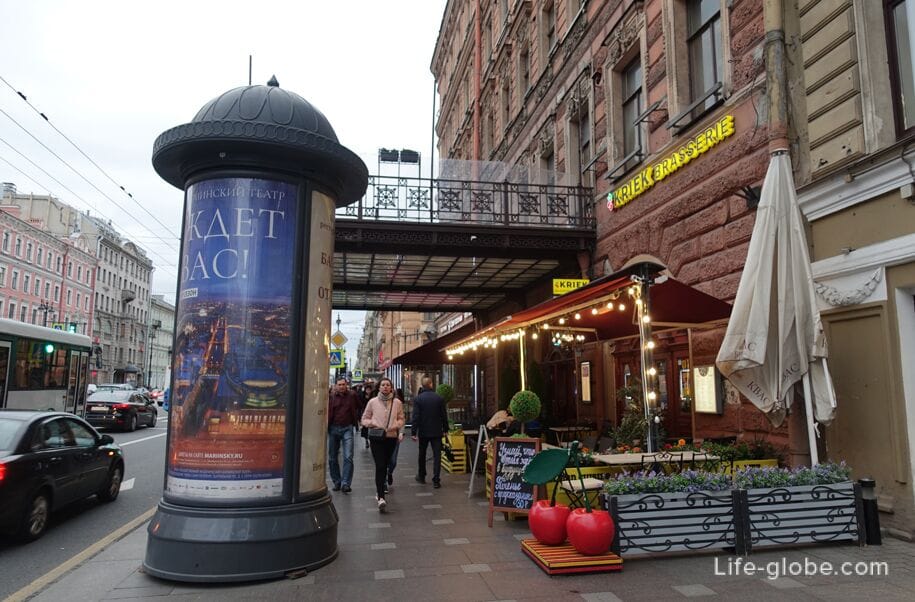
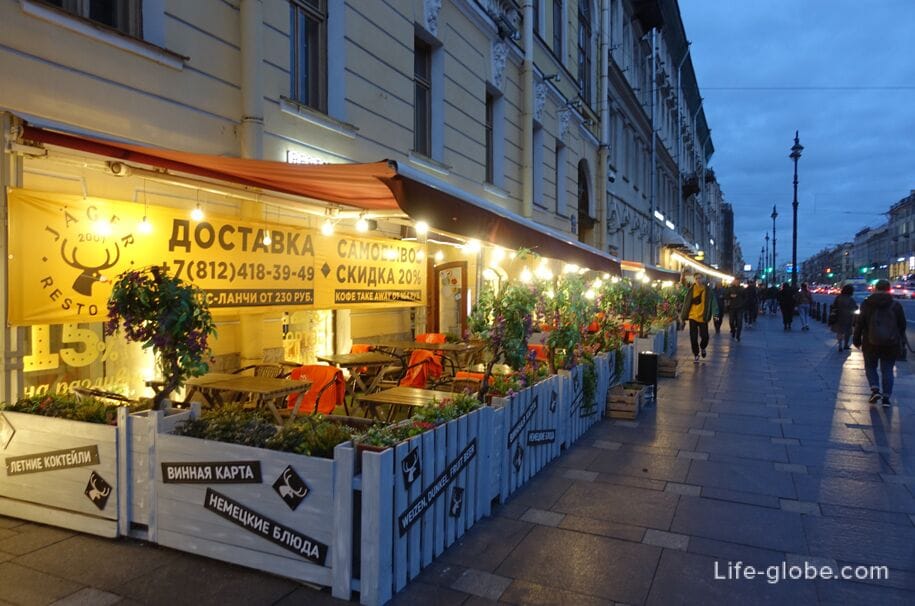
Together with the complex of monuments located along the avenue, Nevsky is included in the list of UNESCO World Heritage Sites.
Conditionally Nevsky Prospekt can be divided into two segments:
- "Front", which stretches from the Alexander Garden to the Vosstaniya Square. It is on this segment that the main attractions of the avenue are concentrated, and it is a popular place for tourists to walk;
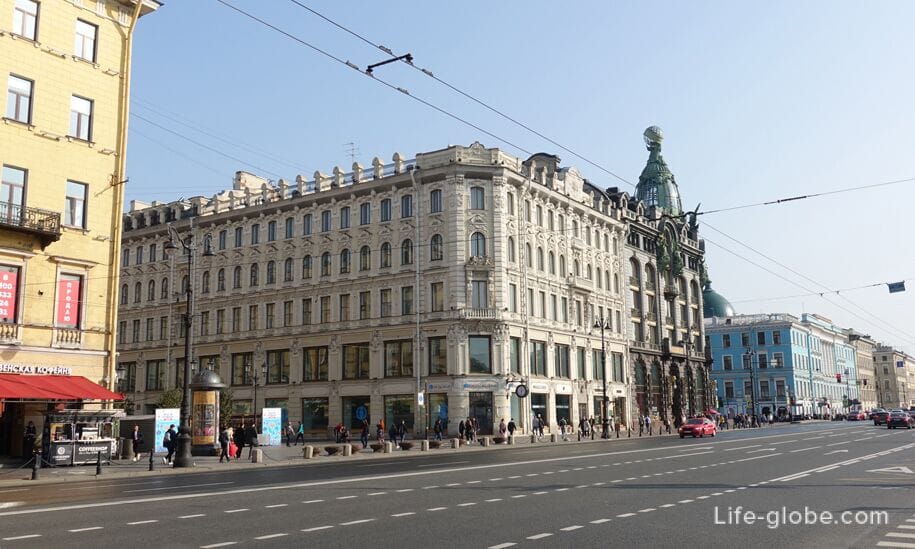

- the eastern section of the avenue, which stretches from Vosstaniya Square to Alexander Nevsky Square, is less popular, but, nevertheless, no less beautiful.
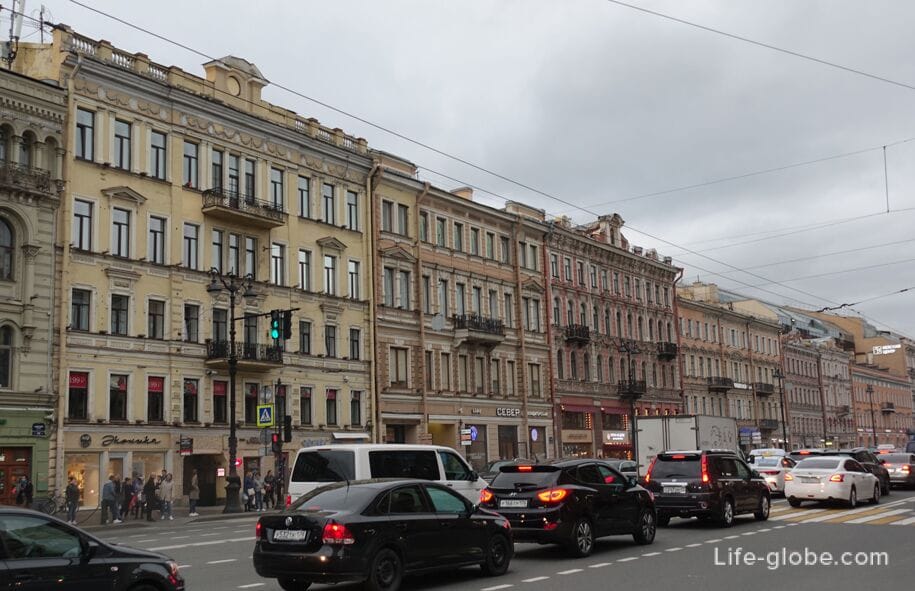

Heydenreich House (Nevsky Prospekt 1)
The Heydenreich House, also known as the St. Petersburg Private Commercial Bank or the Glukhovsky House , is the first building that welcomes its guests on Nevsky Prospekt.
This historic building with a rounded corner facade was built in the late 1770s in the style of Russian classicism for the Saxon ensign Georg Heydenreich, who moved his tavern from the Ovtsyn House (Nevsky Prospekt, 16) to the new building.
Subsequently, the building changed owners. In 1880, the house was purchased by Major General A. I. Glukhovsky, who ordered two six-story courtyard wings to be built to the building. In 1910-1911, the building was sold to the St. Petersburg Private Commercial Bank, whose owners completely rebuilt the building according to the project of architect V. P. Zeidler: the fifth and attic floors were added, an 11-meter reinforced concrete lintel appeared in the courtyard, a grand lobby with a marble staircase was created inside, as well as new offices.
Today, the facade of the building with an arched colonnade of the Ionic order is made in the neoclassical style. The imposing appearance of the building is emphasized by the stone cladding, and the first floor is expressed by wide storefronts.
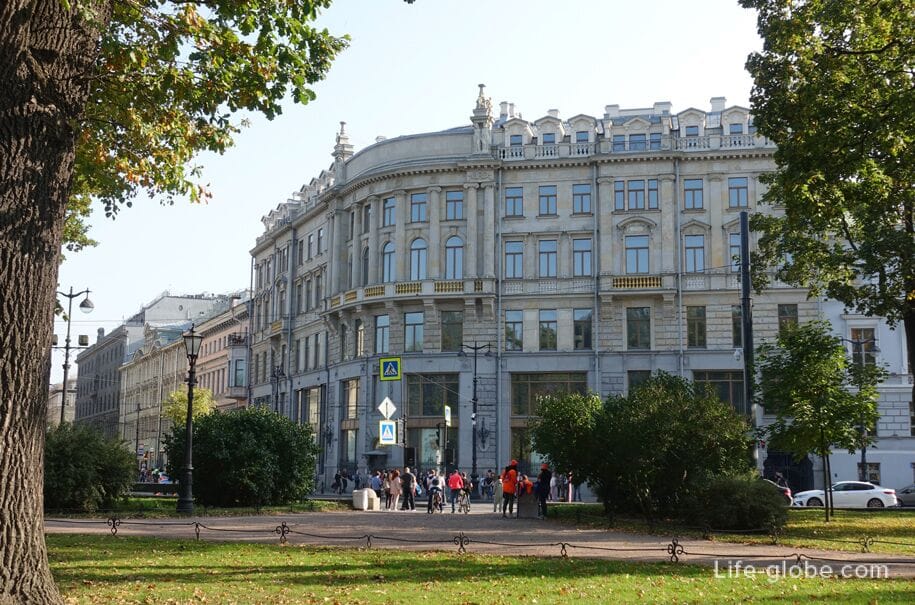
Wawelberg House (Nevsky Prospekt 7-9)
The Wawelberg House (Saint Petersburg Commercial Bank) is a former apartment building and commercial bank.
The building was built in 1910 for the St. Petersburg Merchant Bank. The customer of the construction was Mikhail Ippolitovich Wawelberg-the heir of the founder of the St. Petersburg Merchant Bank (1846)-the merchant of the first guild of Hirshem Wawelberg.
The building was built according to the project of the architect Marian Marianovich Peretyatkovich.
The Neo-Renaissance building stands out among the surrounding buildings, attracting attention with its massiveness and dark color, which give the impression of the heaviness of the structure. More about Wawelberg House…
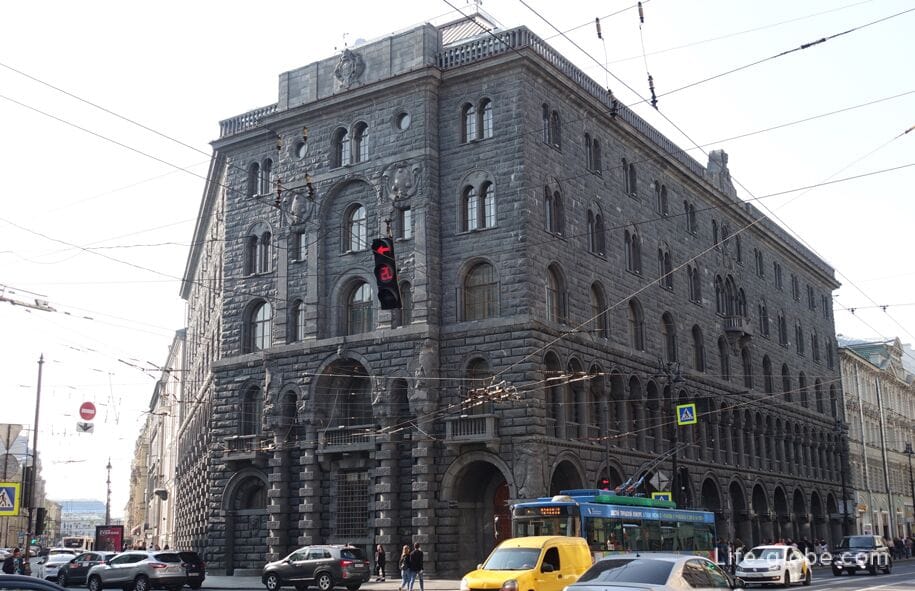
Treiberg House (Nevsky Prospekt 11)
The Treiberg House or Sievers House was built in 1802-1804 as a four-story apartment building in a simple classical style. The owner of the house was a distinguished citizen - Thomas Sievers.
Subsequently, the owners of the house changed, and in the building, among other things, there were shops.
In the 1880s, the owner of the house was a merchant of the 1st guild, Alexander Ivanovich Treiberg. Trading was a supplier to the Imperial Court and maintained a large store in the building that sold interior items.
The house acquired its modern appearance in 1898-1900, when it was rebuilt by the architect L. N. Benois. The building became a five-story building, with eclectic facade decoration, and the windows of the first two floors became large storefronts.
After 1917, the building was nationalized and turned into a residential building with retail space on the ground floor.

Chaplin House (Nevsky Prospekt 13)
The Chaplin House was built in 1804-1806 in the style of Russian classicism under the direction of architect V. I. Beretti as a mansion for the Chaplin merchants.
The building was erected on the site where the temporary Winter Palace of the Empress Elizabeth Petrovna (daughter of Peter I) stood. The temporary palace was erected during the construction of the capital building of the new Winter Palace and dismantled in 1762. Learn more about the Winter Palace…
Subsequently, the owners of the Chaplin house changed. The house was profitable-apartments in the house were rented out.
Today, the building houses residential apartments and commercial premises.
The four-story house has kept its appearance almost unchanged. Above the windows of the third floor are notable rectangular and triangular sandricks, in the center of the facade is a triangular pediment.
In the house you can stay: cozy apartment on Nevsky prospect with free Wi-Fi, air conditioning, refrigerator and kettle; Apartment on Nevsky prospect 13 with 2 bedrooms, free Wi-Fi and private parking.
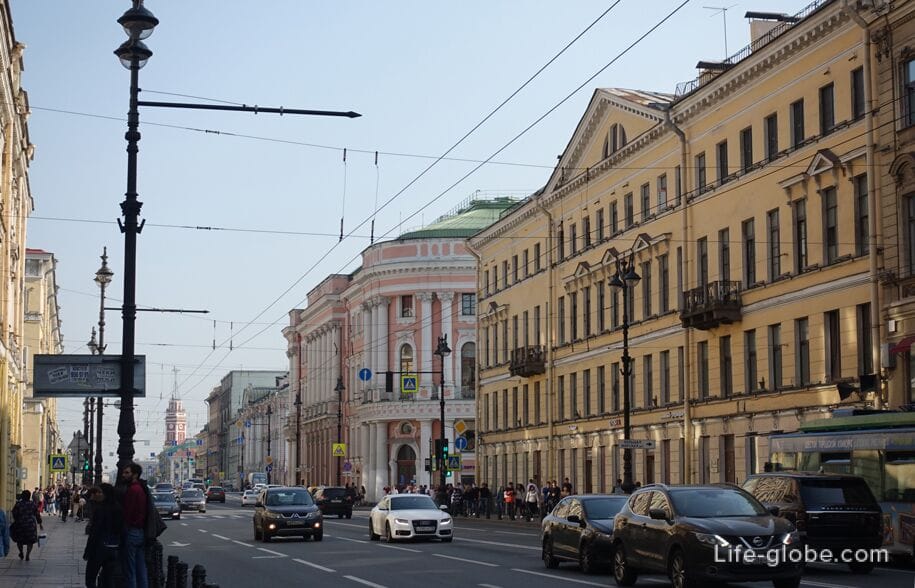
Bolshaya Morskaya Street
Behind the Chaplins ' house, Nevsky Prospekt is crossed by Bolshaya Morskaya Street, part of which is pedestrian and leads to The arch of the General Staff, behind which is the Palace Square.
View of the pedestrian part of Bolshaya Morskaya Street from Nevsky Prospekt
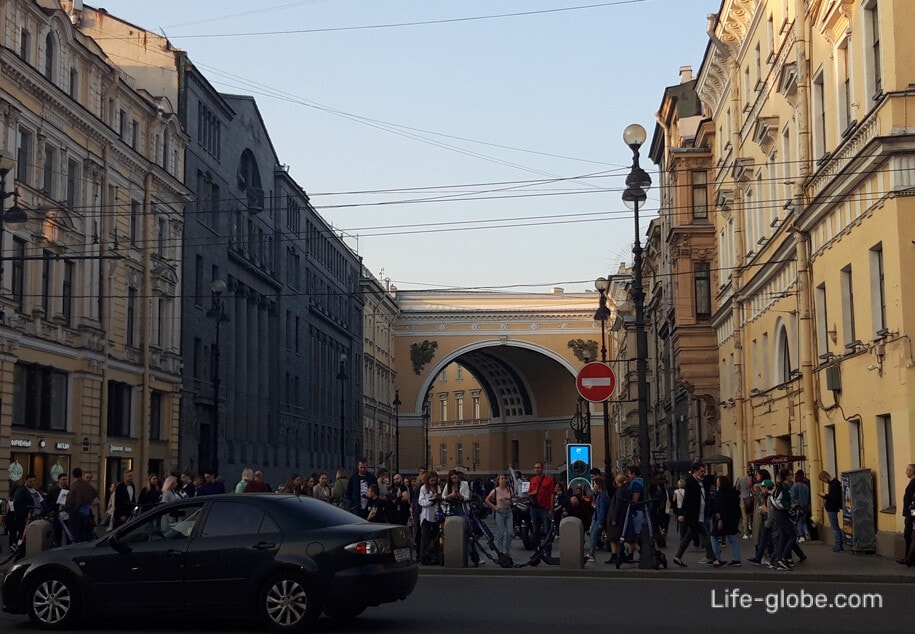
House of L. Ya. Ovtsyn
Corner building located at the address: Nevsky Prospekt 16 / Bolshaya Morskaya Street 7-house of L. Ya. Ovtsyn (S. M. Tedeski).
The building was built in 1766 by the architect Alexey Vasilyevich Kvasov for Lieutenant General Larion Yakovlevich Ovtsyn.
In the second half of the 1870s, Stanislav Mikhailovich Tedeski, a merchant of the 1st guild, became the owner of the building. For him, in 1880-1881, the house was rebuilt by the architect Ludwig Frantzevich Sperer: the building had a fifth floor, and the facades were decorated in the eclectic style; the first two floors were opened with wide showcases.
Subsequently, the owners of the house changed, the premises were rented out to citizens for living and for commerce. The two lower floors were also rebuilt - the shape of the storefronts was changed, the retail premises were updated, and the facade of the building acquired elements of the Art Nouveau style.
In the building you can stay: At Hermitage Guest House with family rooms, free Wi-Fi and heating; Exclusive living City Centre - Sleeps 20 apartment with a bedroom, an equipped kitchen, heating and air conditioning.
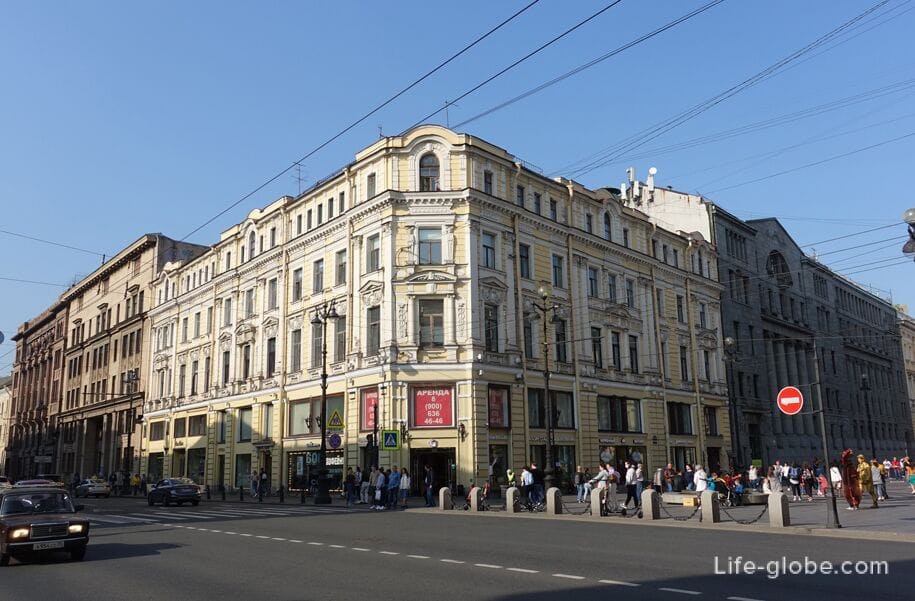
I.G. Neumann House
Corner building located at the address: Nevsky Prospekt 18 / Bolshaya Morskaya Street 12 - the house of I. G. Neumann, also known as the house of K. B. Kotomin (after the names of the owners).
The two-story stone house was built in 1741 by the architect Mikhail Grigoryevich Zemtsov for the tailor I. G. Neumann. In 1806, the house was bought by the merchant K. B. Kotomin, who radically rebuilt the house according to the project of the architect Vasily Petrovich Stasov - the building acquired the features of classicism and was used as an apartment building.
Today, the building has four floors, is made in the style of high classicism and is divided into two main tiers. The lower tier is decorated with four-column loggias on the sides of the main facade.
The building stretches along Nevsky Prospekt for a whole block-to the embankment of the Moika River (house 57).
In the building you can stay: apartment on Nevsky 18 with 2 bedrooms, free Wi-Fi and Parking; apartment with a view of the Moika and access to the Palace with 2 bedrooms and air conditioning. Learn more about the pedestrian part of Bolshaya Morskaya Street…
View of the Neumann house from Nevsky Prospekt and Bolshaya Morskaya Street
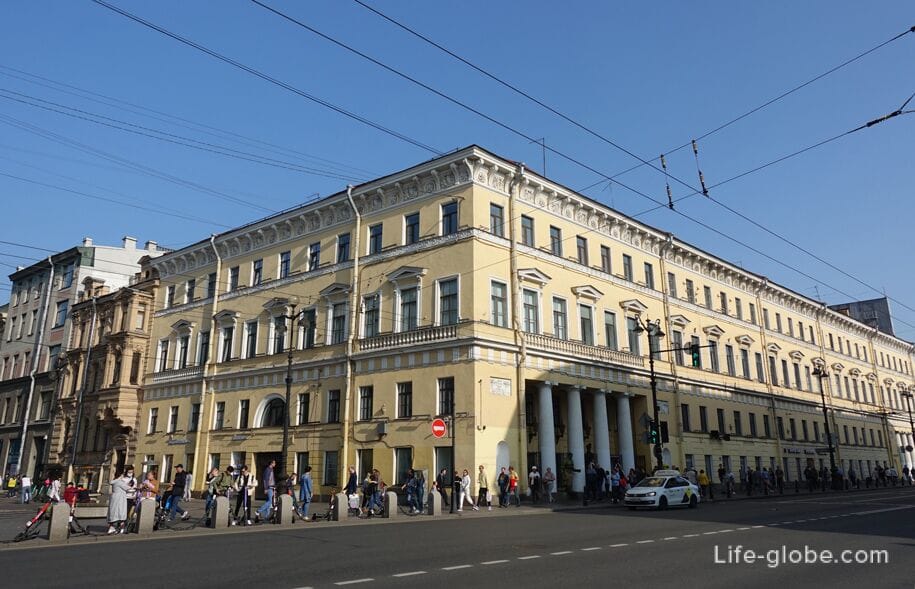
View of the Neumann house from the side of Nevsky Prospekt and the Green Bridge (Moika River embankment)

House-Palace of the Eliseevs (Nevsky Prospekt 15)
On the corner, at the address: Nevsky Prospekt 15 / Moika River Embankment, there is the house-palace of the Eliseevs (Chicherina).
The building was built by 1771 as a palace-mansion in the style of early classicism for the police Chief General Nikolai Ivanovich Chicherin.
Chicherin himself occupied a suite on the third floor. Concerts and masquerades were held in the building, and on the lower floor the Italian merchant Berlotti opened a vegetable shop.
In 1789, due to debts, Chicherin's son, Alexander, sold the house to Prince Alexey Borisovich Kurakin, who commissioned an apartment building to be added to the mansion in 1794.
Subsequently, the building changed several owners and residents, and another building was added to it.
In 1858, the complex of buildings became the property of the Yeliseyev brothers. At the same time, the reconstruction of the building was carried out according to the project of the architect N. P. Grebenka.
In 1902-1904, according to the plan of Stepan Petrovich Eliseev, the interior of the palace was rebuilt. At the end of the restoration, the Eliseevs lived in a wing of the building located on the Moika River embankment, and the wing facing Nevsky Prospekt was occupied by the bank's operating room. A number of other premises were rented out.
After the revolution of 1917, the Yeliseyevs were forced to emigrate, and their house was nationalized.
Since 1993, a major reconstruction of the complex of buildings has begun.
In 2003, the grand opening of the 5-star Talion Imperial Hoteltook place , which, to this day, is located in a complex of buildings. Guided tours are also available in the premises of the former mansion. Some rooms are rented out. Read more about the house-palace of the Eliseevs…
View of the building from Nevsky Prospekt
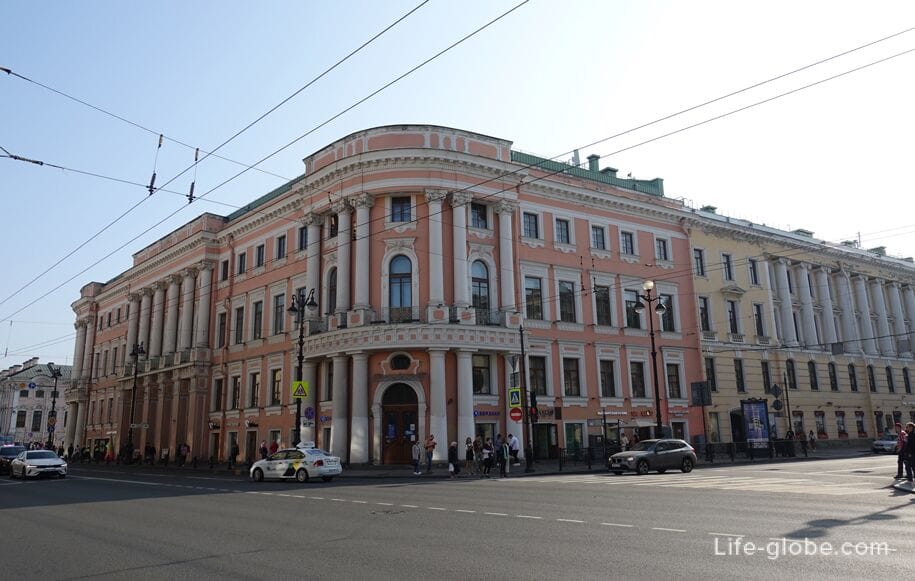
View of the building from the Moika River embankment (from the Green Bridge)
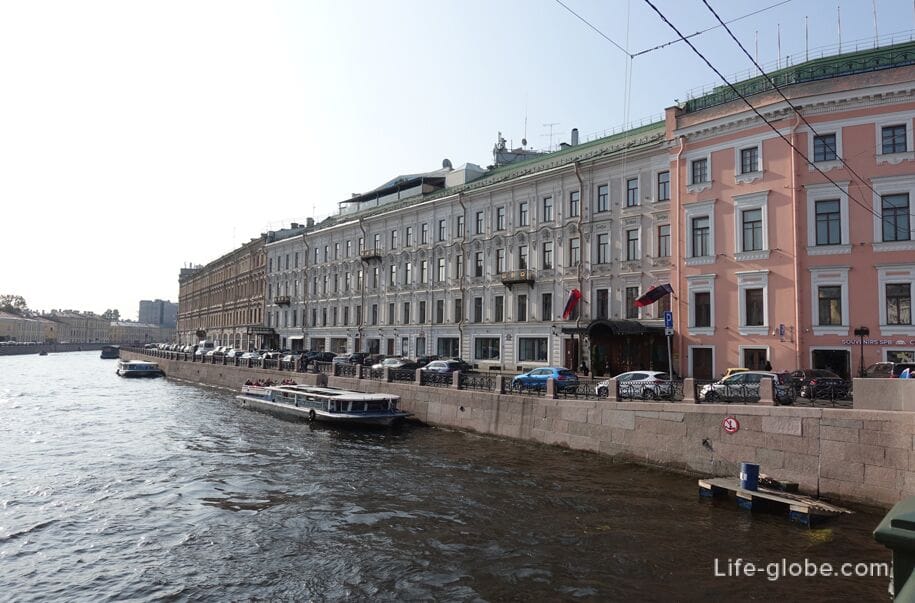
The interior of the former palace
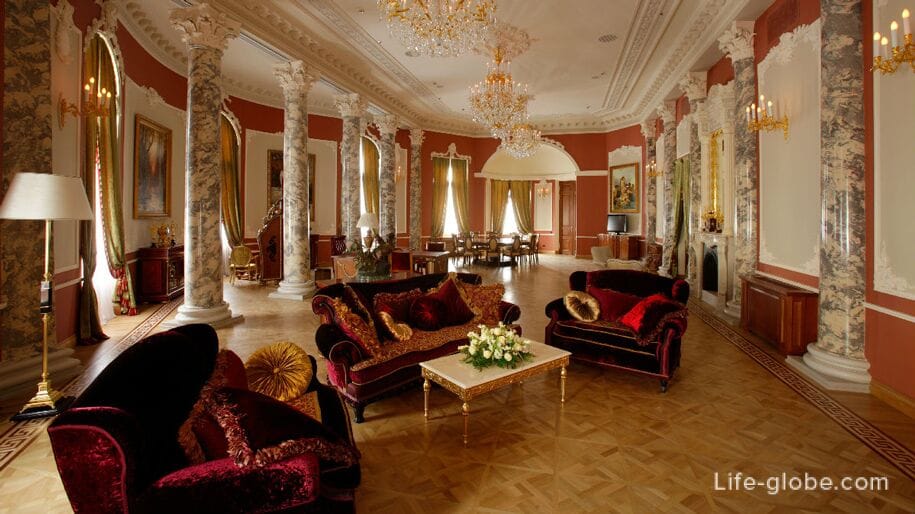
Green Bridge
The Green Bridge is located on the axis of Nevsky Prospekt and connects the Kazan and 2nd Admiralty Islands across the Moika River.
The first wooden drawbridge was built in 1716-1717. In 1735, the crossing was repaired, painted green and officially given the name "Green Bridge".
A cast-iron single-span bridge on this site was built in 1808, designed by an engineer and architect of Scottish origin, V. I. Geste.
In 1842, due to the increased traffic on Nevsky Prospekt, the bridge was expanded according to the project of engineer A. D. Gottan.
In 1904-1907, in connection with the laying of tram tracks on Nevsky Prospekt, the bridge was rebuilt and expanded according to the project of engineers V. A. Bers, A. L. Stanovoy and A. P. Pshenitsky and architect L. A. Ilyin.
In the future, the bridge was restored and improved.
Today, the Green Bridge is a single-span metal structure of an arched structure with a length of 30 meters and a width of 38.6 meters in the axes of the railing. The pattern of cast iron railings follows the pattern of the Moika River fence. Read more about the Green Bridge...
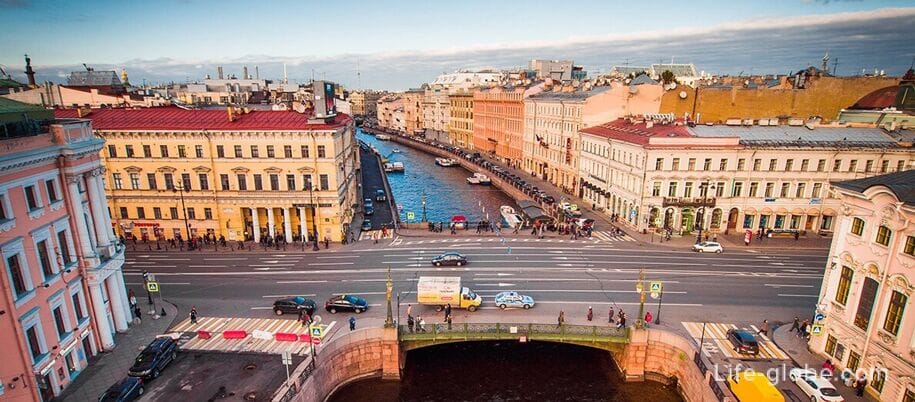

Stroganov Palace (Nevsky Prospekt 17)
Stroganov Palace (Stroganov Palace) is a former palace and occupies a corner on Nevsky Prospekt and the Moika River embankment.
The formation of the palace began in the 1720s, when one-story chambers belonging to the Stroganov family were built. Later, Baron S. G. Stroganov bought an unfinished two-story house here.
As a palace, the Stroganov estate was built in 1753-1754, when the architect of Italian origin Francesco Bartolomeo Rastrelli united the Stroganov houses into a single whole with a common facade belonging to the Baroque style.
In the late 18th and early 19th centuries, Andrey Voronikhin reconstructed and re-created a number of interiors of the palace in the classical style, including in the newly added eastern building. In 1842, Peter Sadovnikov completed the formation of the southern building of the palace and stylistically united all the courtyard facades.
After the revolution, in 1918, the Stroganov Palace was nationalized and turned into the"People's House-Museum (formerly Stroganov)".
Since 1988, the building has been transferred The Russian Museum. Today, in the walls of the Stroganov Palace, you can see some restored rooms and halls. Learn more about the Stroganov Palace…
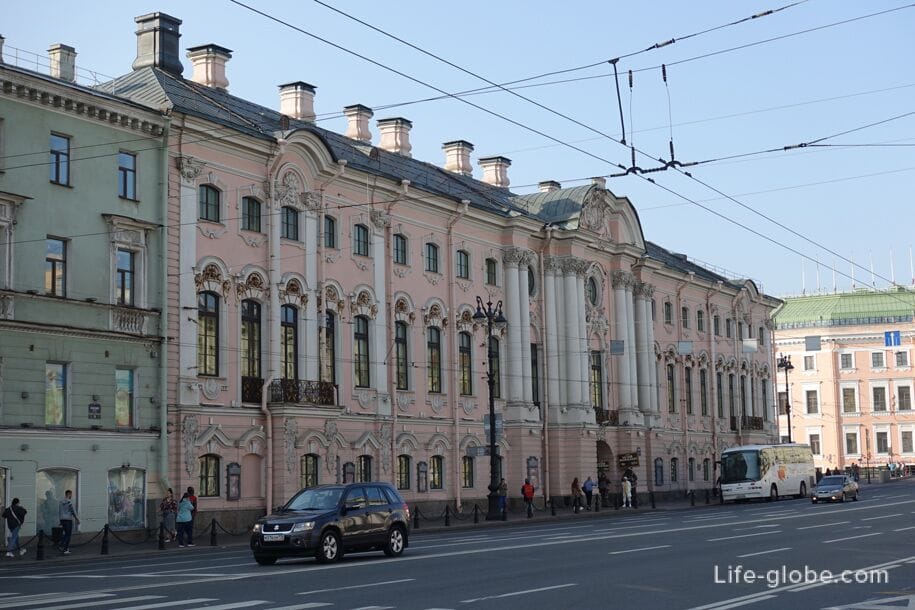
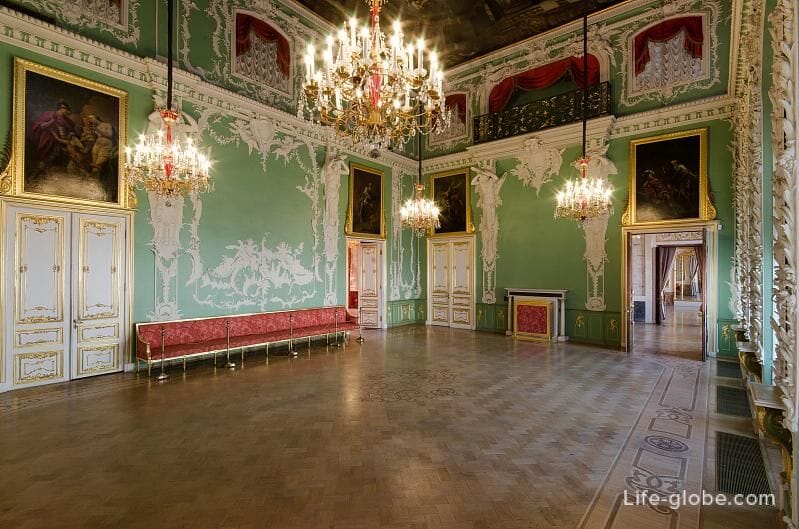
Dutch Church (Nevsky Prospekt 20)
The House of the Dutch Reformed Church or simply the Dutch Church is a former church of the Dutch Reformed Church.
The church building was built in 1831-1835 by the French-born architect Paul Jacot in the style of Russian classicism on the site of a house owned by the Dutchman Pierre Puzy.
After the revolution of 1917, in 1926, services were discontinued, and the church building was nationalized and housed various organizations.
Currently, the building houses, among other things, residential apartments, commercial premises and the Center for Art and Music of the Mayakovsky Central State Library.
The building stretches for a whole block along the northern side of Nevsky Prospekt, between the Moika River embankment and Bolshaya Konyushennaya Street.
In the building of the former Dutch church, you can become in apartments near the Hermitage with free Wi-Fi, free parking and 2 bedrooms. More about the house of the Dutch Reformed Church…
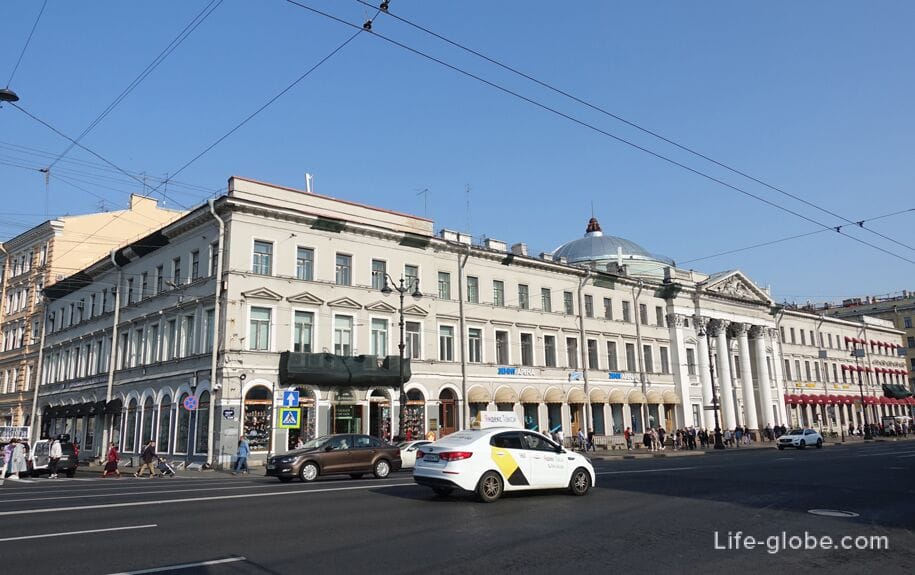
Mertens House (Nevsky Prospekt 21)
The Mertens House is a historic building and architectural monument, which is one of the first neoclassical monuments in St. Petersburg.
The current building was built in 1911-1912 by order of F. L. Mertens as a trading house of the Mertens fur company.
Today, the building houses a restaurant and a Zara store.
The main facade of the building faces Nevsky Prospekt and has three high glazed arches. The arched pillars are Corinthian semi-columns with pilasters. The upper (fifth floor) is decorated with six wide-spaced windows, the piers between which are decorated with sculptures-bucranions with garlands and ornamental panels connected in a single whole with the keystones above the arches. More about Mertens House…
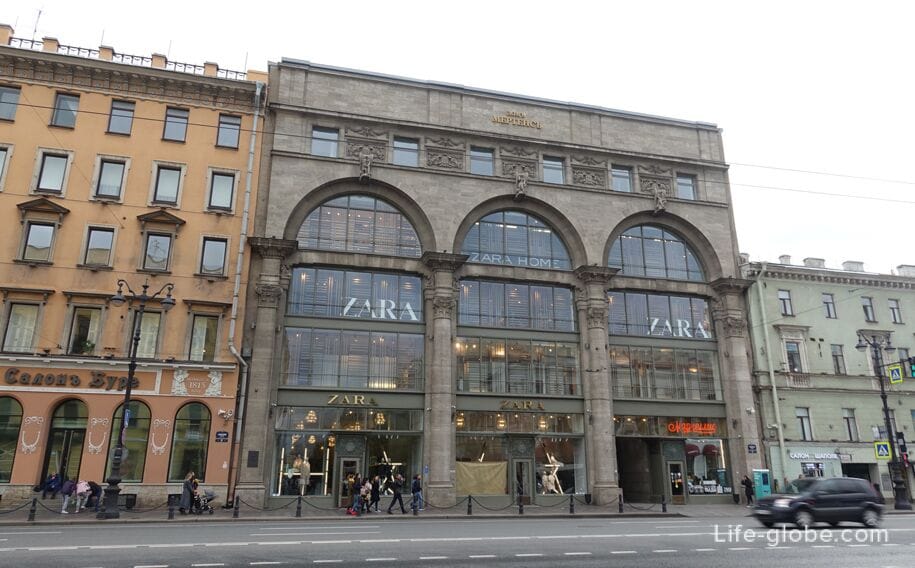
Bolshaya Konyushennaya Street
Opposite the Mertens house, Bolshaya Konyushennaya Street adjoins Nevsky Prospekt, along which there are historical buildings, a church, the famous Pyshechnaya Zhelyabova 25 and a theater, as well as shops and boutiques, restaurants and accommodation facilities.
The street is a roadway, with pedestrian sidewalks on both sides. The roadway of the street is paved with paving stones.
The center of the street forms a boulevard, on which there are three sculptures of horses made by the sculptor Vasily Nikolaevich Azemsham. More about Bolshaya Konyushennaya Street…
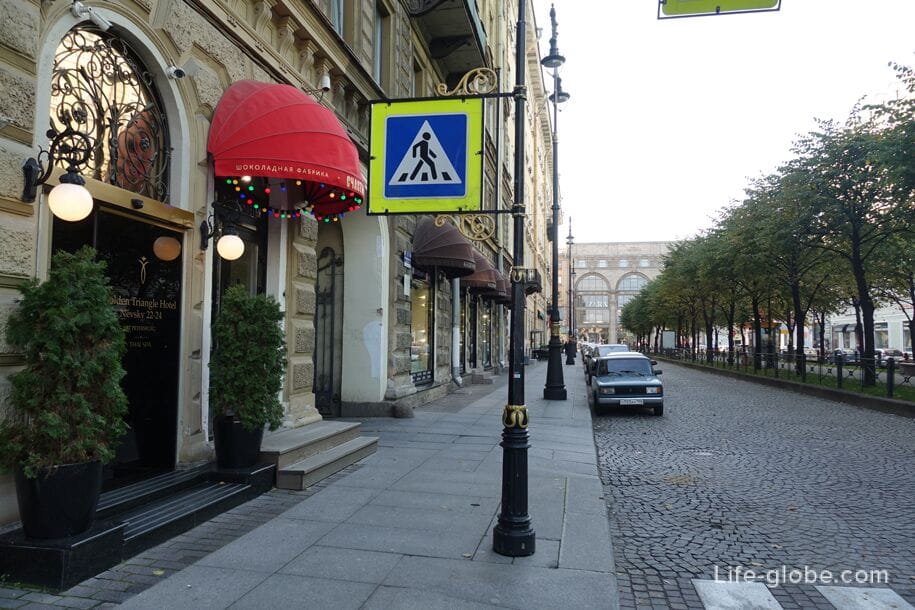

Ensemble of the Church of Saints Peter and Paul (Nevsky Prospekt 22-24)
The Lutheran Church of Saints Peter and Paul (Petrikirche) in St. Petersburg is the largest Evangelical Lutheran church in Russia.
The Church of Saints Peter and Paul hosts services, guided tours, including the catacombs of the Petrikirche, exhibitions and cultural events. The church has organs.
The current building of the church is the second, and was built in the period from 1833 to 1838 by the architect and artist Alexander Pavlovich Bryullov. Subsequently, the facades and interiors of the church underwent restorations and artistic additions.
Today, the Petrikirche is a functioning Lutheran church. It has classic features with two symmetrical square towers.
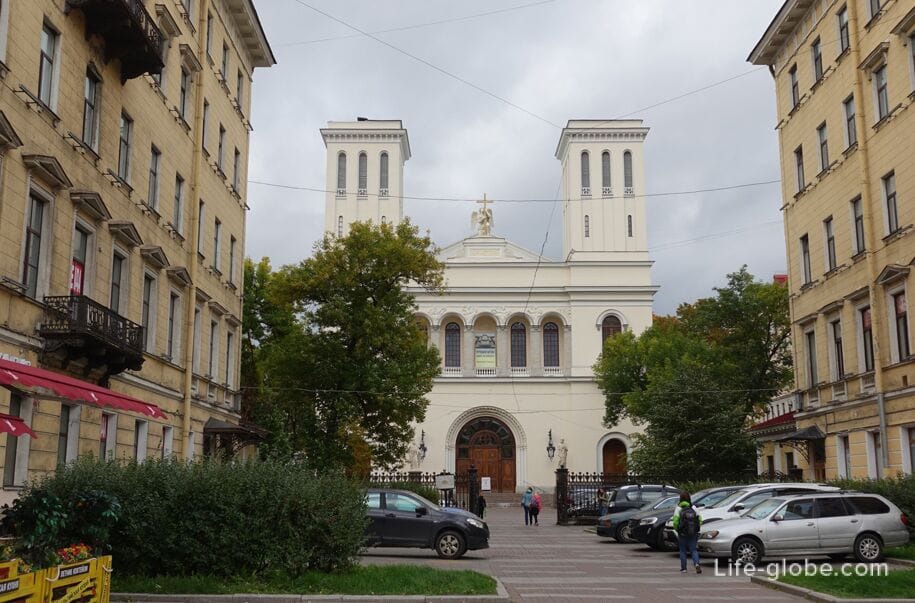
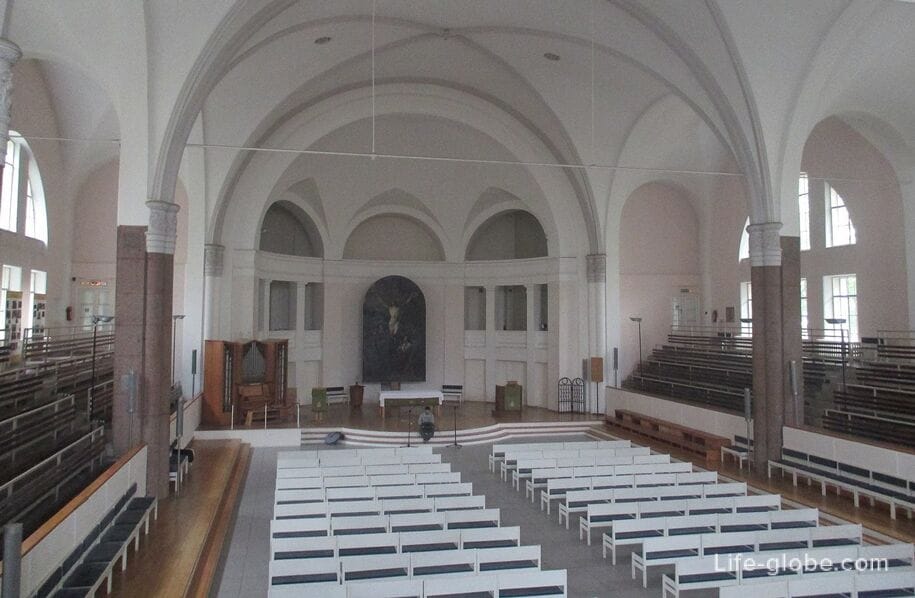
The Petrikirche is located in the back of the buildings on Nevsky Prospekt.
From the very beginning, the church was not a single structure, but was part of an ensemble consisting, in addition to the church itself, also of a school ("Petrishule") and two apartment buildings, which were modified over the course of history.
The buildings include: RiverSide Hotel Nevsky with a 24-hour front desk and a shared lounge with a TV; Nevsky 22 LUX Apart Apartment with free Wi-Fi and private parking; Apartment on Nevsky 24 Apartment with free Wi-Fi and free toiletries. Learn more about the Petrikirche Ensemble…
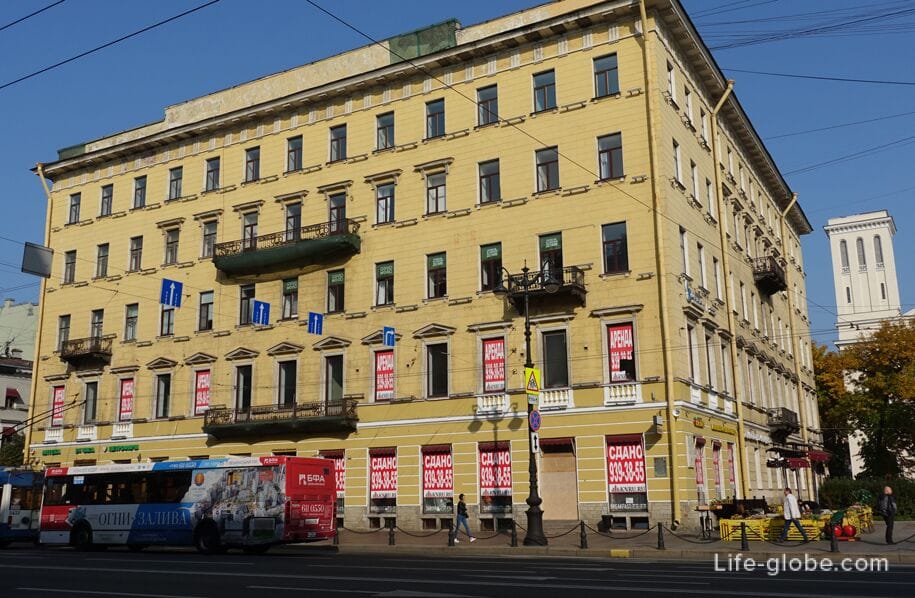

Stroganov House (Nevsky Prospekt 23)
The house was built in 1838-1839 on the site of a small building commissioned by S. V. Stroganov and designed by architect P. S. Sadovnik. The house had three floors and was made in the forms of late classicism.
In 1908, according to the project of the architect D. A. Shagin, the building was built on two more floors. In the building, among other things, there was a shop selling Swiss watches of the trading company "Pavel Bure".
In 1912, the first light advertising in St. Petersburg was installed on the roof of the Stroganov House.
Currently, the building houses the SKA Hockey Club brand store and other retail premises.
In the house you can stay: 2-star guest house Abazhur on Nevsky, hostel Wonderland on Nevsky, duplex studio apartment Apartments on Nevsky 23.
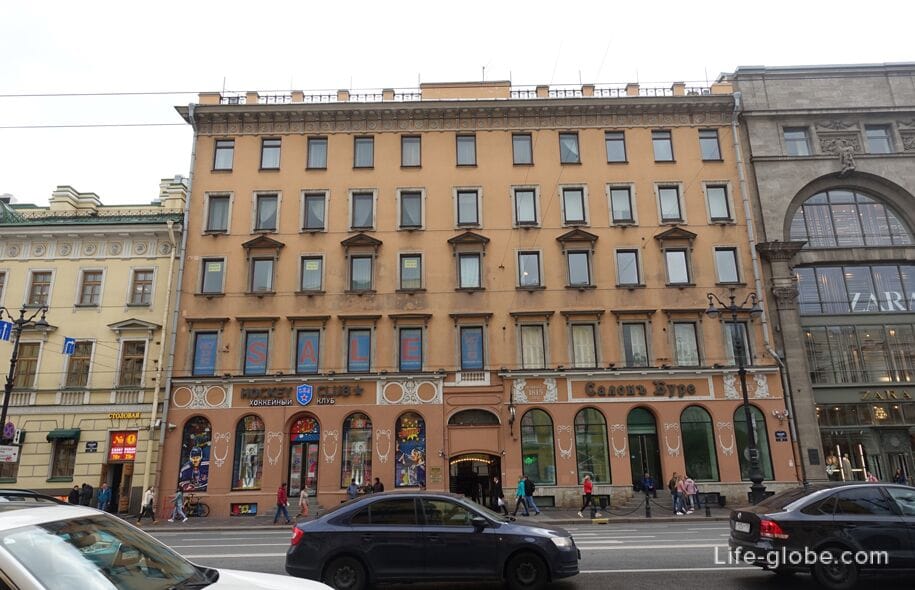
House of the Kazan Cathedral (Nevsky Prospekt 25)
The House of the Kazan Cathedral (the House of the Clergy of the Kazan Cathedral) is a building built in 1813-1817 on the site of a former mansion, in the style of Russian classicism under the direction of architect V. P. Stasov.
In 1840, according to the project of the architect P. S. Plavov, the building was united stylistically by a single facade with the neighboring building on Kazanskaya Street.
From the beginning of the 19th century until the closure of the Kazan Cathedral (1932), the house was inhabited by clergymen, including the abbots, of the nearby Kazan Cathedral.
Subsequently, the apartments in the house were rented out, and commercial premises were located on the first floor.
After the October revolution of 1917, the vast majority of apartments in the house became communal.
In 1933, according to the project of architects D.P. Buryshkin and I.G. Kaptsyug, the house was built on the fourth floor.
In 1995-1997, the building was slightly rebuilt by architects S. I. Sokolov and N. I. Yavein as the Atrium on Nevsky 25 shopping center. The courtyard was made closed, covering it with a glass roof. A small fountain was installed in the center of the courtyard. The last (4th) floor became an attic. The authors of the project of the new appearance of the building were awarded the State Prize for Architecture.

Kazan Cathedral (Nevsky Prospekt 25x)
Kazan Cathedral (Cathedral of the Kazan Icon of the Mother of God) is one of the largest churches in St. Petersburg.
The cathedral is a cathedral.
Kazan Cathedral was built according to the idea of Emperor Paul I, on the site where there was a modest church of the Nativity of the Virgin, which kept one of the main St. Petersburg shrines-the miraculous icon of the Kazan Mother of God.
The church was laid on August 27 (September 8, new style), 1801, in the presence of Emperor Alexander I, the son of Paul I. The construction of the cathedral was carried out in 1811 according to the project of the architect Andrey Nikiforovich Voronikhin as the cathedral of the city for the storage of the icon of the Mother of God of Kazan.
Today, the Kazan Cathedral is an outstanding monument of Russian history, architecture and fine arts.
The center of the cathedral is crowned by a large and slender dome with a cross. The main facade with a colonnade, two standing monuments and a sprawling square of the same name with a fountain, the cathedral faces Nevsky Prospekt.
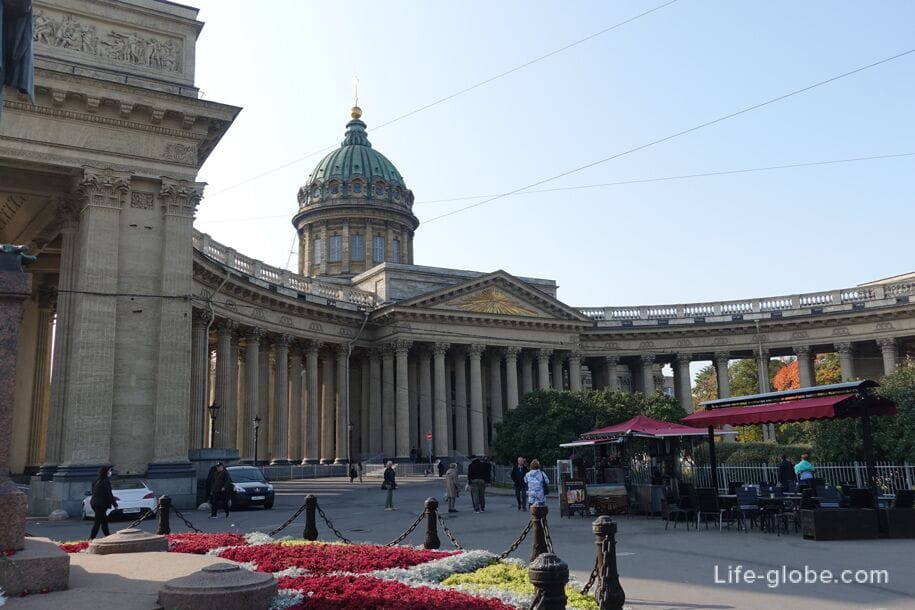
Inside, the cathedral has the shape of a Roman basilica, divided by rows of granite monolithic columns into three naves (corridors).
An integral part of the interior of the cathedral is painting. The iconostasis of the cathedral was painted by the best artists of the late 18th and early 20th centuries.
The main shrine of the cathedral is the venerated image of the Kazan Icon of the Mother of God, a list (copy) of the miraculous icon found in Kazan in 1579. Although the icon in the St. Petersburg cathedral is a copy, it, like the original icon itself, is recognized as miraculous. Learn more about Kazan Cathedral…
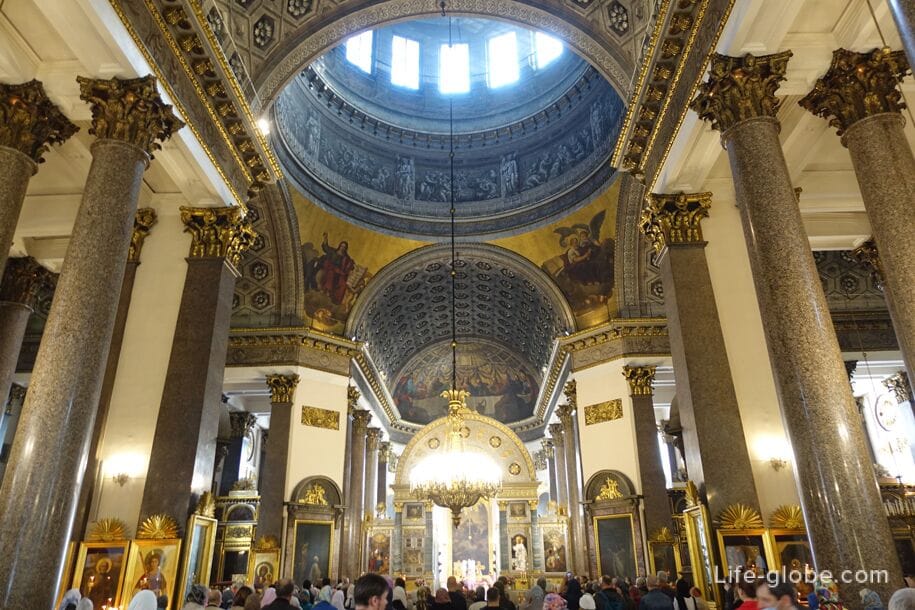
Malaya Konyushennaya Street
Opposite the Kazan Cathedral, Malaya Konyushennaya Street adjoins Nevsky Prospekt.
The street is pedestrian, the main attractions of which are: the Swedish Church of St. Catherine, the residential building of the Evangelical Swedish Church of St. Catherine, the monument "Weather Pavilion", the museum-apartment of M.M. Zoshchenko, the monument to the policeman and the monument to N.V. Gogol. Read more about Malaya Konyushennaya street...
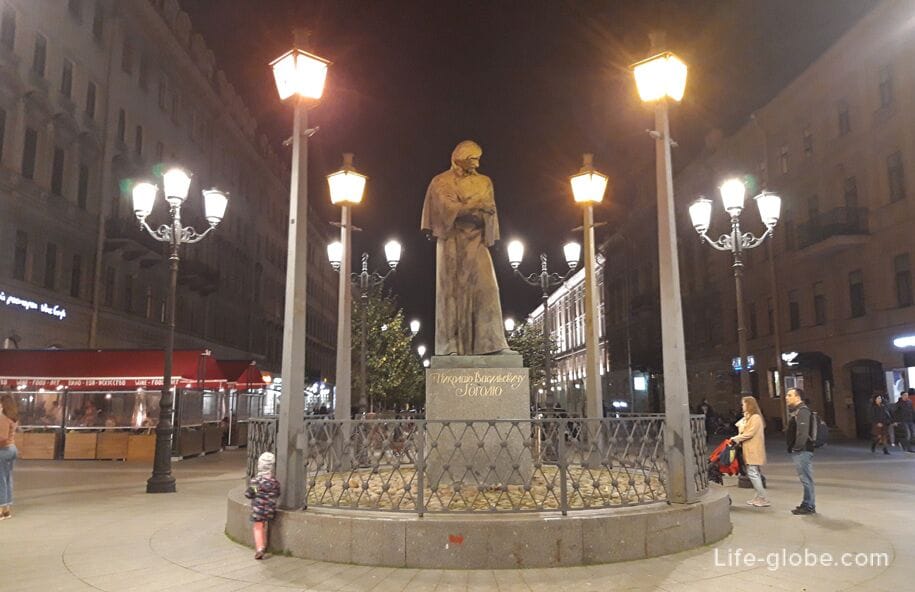
Gansen House (26 Nevsky Prospekt)
The Hansen House was first built in 1776-1777 for the camera-fourier Colonel P. P. Trunov.
Subsequently, the building changed owners. The house housed retail establishments, and 20 apartments were arranged.
In 1873-1874, the architect V. A. Kenel, the house was completely rebuilt by order of the new owner - the Norwegian entrepreneur G. I. Hansen. The building became a five-story building with an eclectic facade. Courtyard outbuildings were also built. It was one of the first buildings in St. Petersburg with storefronts to the height of two floors. The first two floors were intended for shops and offices, the other three were rented out.
In 1912, the architect Karl Karlovich Schmidt changed the decoration of the facades of the two lower floors, redesigned their interiors.
Today, this corner building, facing Nevsky Prospekt and Malaya Konyushennaya Street, still has large windows on the 1st and 2nd floors and multiple architectural details of decoration.


Singer's House (Nevsky Prospekt 28)
The Singer House, also known as the" House of Books", is a famous historical building that is one of the symbols of St. Petersburg.
The building was built in 1902-1904 by architect Pavel Suzor for the "Singer Joint-Stock Company in Russia". Singer is an American corporation (Singer Corporation).
The building belonged to the company" Singer " until 1917, part of the premises were leased to the bank.
In 1938, the "House of Books" was opened in part of the building, which is still located in the Singer house today.
Today, this corner building, facing Nevsky Prospekt and the embankment of the Griboyedov Canal, stands out in the Art Nouveau style with neo-Baroque elements and numerous decorations on the facades, including large sculptural allegories - bronze groups of two valkyries.
The upper central part of the building is crowned by a large glass dome, on which two female figures hold a "globe".
Within the walls of the building are located: the House of Books, the cafe "Singer" and premises for rent. There are also guided tours of the building, which include access to the Krusha, which offers panoramic views. More about the Singer House…
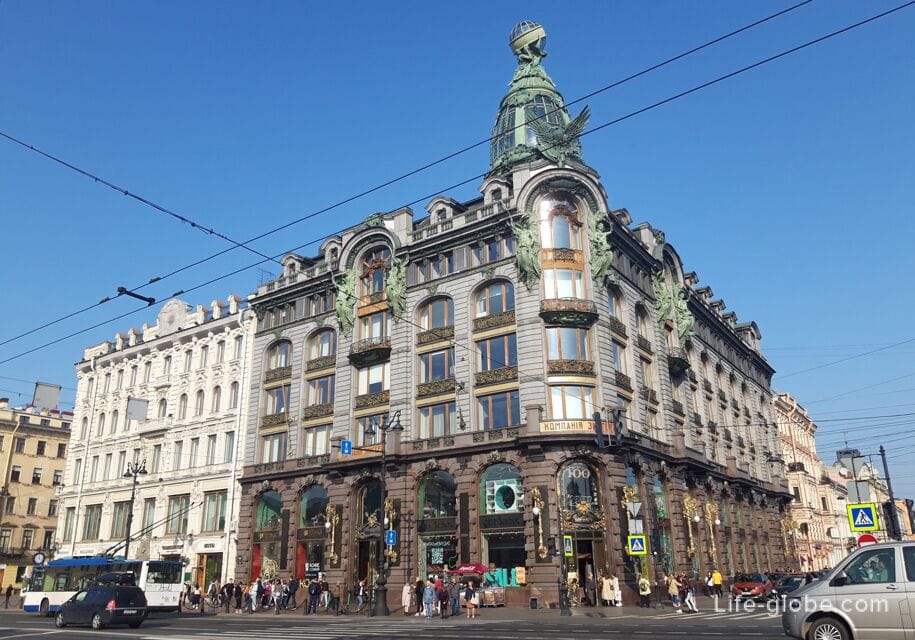
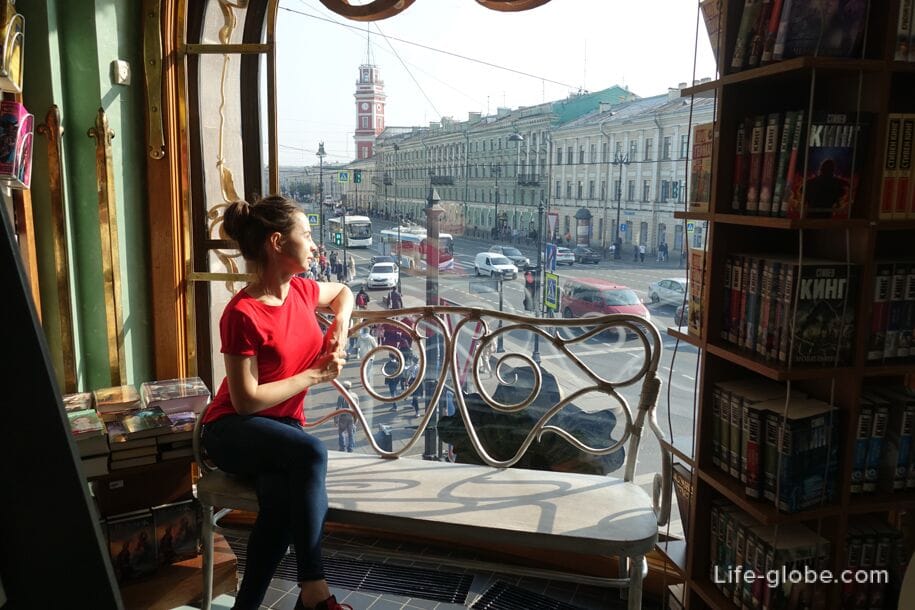
Kazan Bridge
The Kazan Bridge spans the Griboyedov Canal in the alignment of Nevsky Prospekt, and connects the Kazan and Spassky Islands.
The first wooden bridge in this place existed since 1716. In 1766, the crossing was replaced with a new stone single-span vaulted one.
In 1805-1806, in connection with the construction of the Kazan Cathedral and the redevelopment of the nearby part of Nevsky Prospekt, the bridge was rebuilt, presumably, according to the project of the architect L. I. Rusk.
Subsequently, the bridge was restored and strengthened.
Today, the Kazan Bridge is a single-span brick arch with arches lined with granite. The abutments of the bridge are also faced with granite. The railing is a granite parapet.
The length of the bridge is 17.35 meters, its width is 95 meters, and the width of the bridge with openers is 99 meters. This is the third-widest bridge in St. Petersburg after Blue and Aptekarsky bridges.
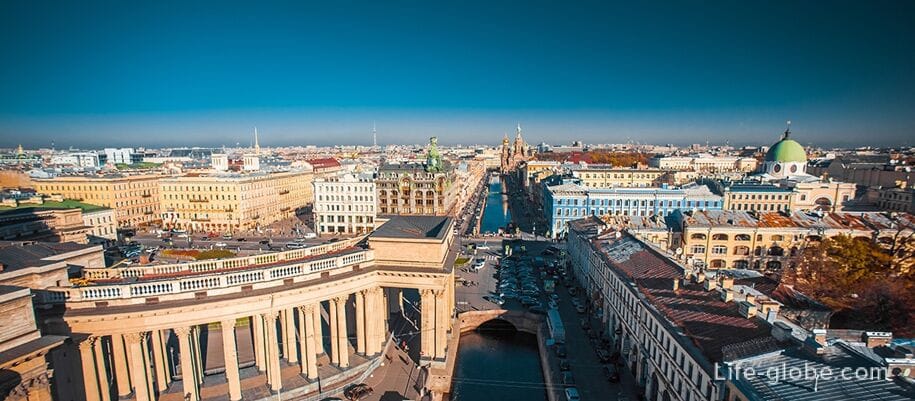
From the Kazan Bridge, you can enjoy stunning views, including the Italian Bridge and famous Saved on Blood.
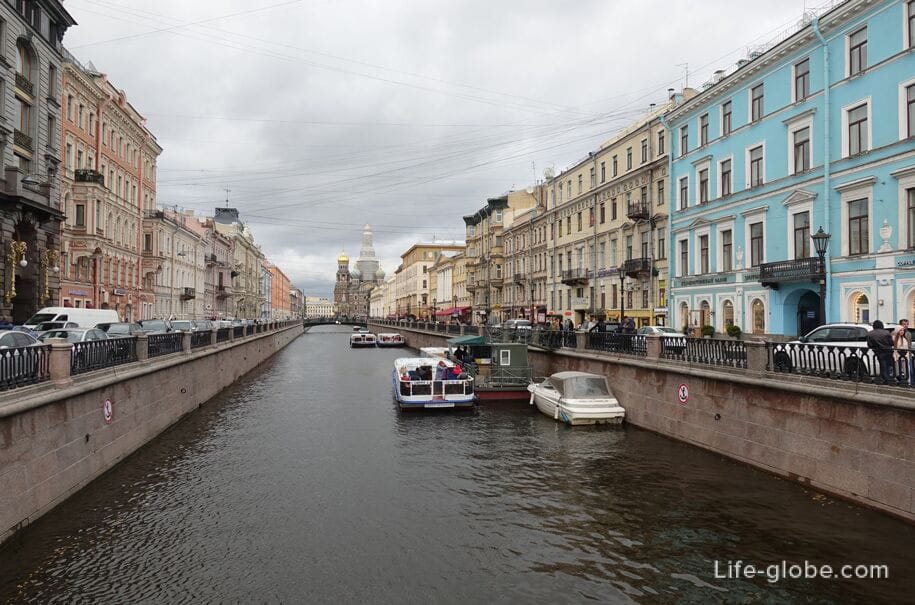
Milyutin House (Nevsky Prospekt 27-29)
Alexey Ivanovich Milyutin was the first owner of the site on Nevsky Prospekt 27-29. It was he who, under Peter I, received the privilege of setting up a factory for the production of braid and brocade in this place. At that time, the Milyutin factory was the only production enterprise on Bolshaya Perspektivnaya Road (now Nevsky Prospekt), and this is explained by the fact that in those years the street was not yet the main street of the city, but only the main entrance road to the city.
In 1736, Mityunin began construction of a long two-story building along Nevsky Prospekt with twelve shops. Then Milyutinsky Rows became the first large commercial building in this part of the city.
In the 1770s, a three-story house was built on the corner with the Catherine Canal (now the Griboyedov Canal).
In the 1790s, the owner of the site was the headman of the nearby Church of the Nativity of the Virgin (now Kazan Cathedral)-Sila Glazunov. His house became the place of work of the commission for the construction of the Kazan Cathedral.
Until the middle of the 19th century, Milyutinsky Rows were known to St. Petersburg residents for their fruit and wine shops. Nikolai Vasilyevich Gogol mentioned them in his work "Dead Souls", in the part where he tells about Captain Kopeikin: "Will it pass by the Milyutinsky shops? There's a sort of salmon looking out of the window. Cherries for five rubles a piece, a watermelon-a huge one, a kind of stagecoach, leaned out of the window and, so to speak, is looking for a fool who would pay a hundred rubles."
In the 1820s, the Milutinsky Rows were rebuilt into a four-story apartment building in the style of late classicism. The first floor of the house was occupied by shops.
Subsequently, the buildings changed owners and underwent some alterations. In 1881, the facade of house No. 27 was changed, in 1883-the facade of house No. 29. The work was carried out according to the project of S. O. Shestakov.
During the Great Patriotic War, house 27 was severely damaged. The building was restored in 1944. In 1965, one of the first beer halls in Leningrad was opened here.
Today, the two houses are outwardly different from each other. The house at number 27 has a new facade, close to the time before the reconstruction in the 1880s and is distinguished by pilasters with capitals.
The facade of the house No. 29 is distinguished by the windows of the first floor in the form of arches and the attics crowning the building.
In the houses you can stay: Apartment on Griboyedova 18 apartment with two bedrooms, free Wi-Fi and parking; Feelathome Apartments - Nevsky apartment with 2 bedrooms and a hot tub / jacuzzi.

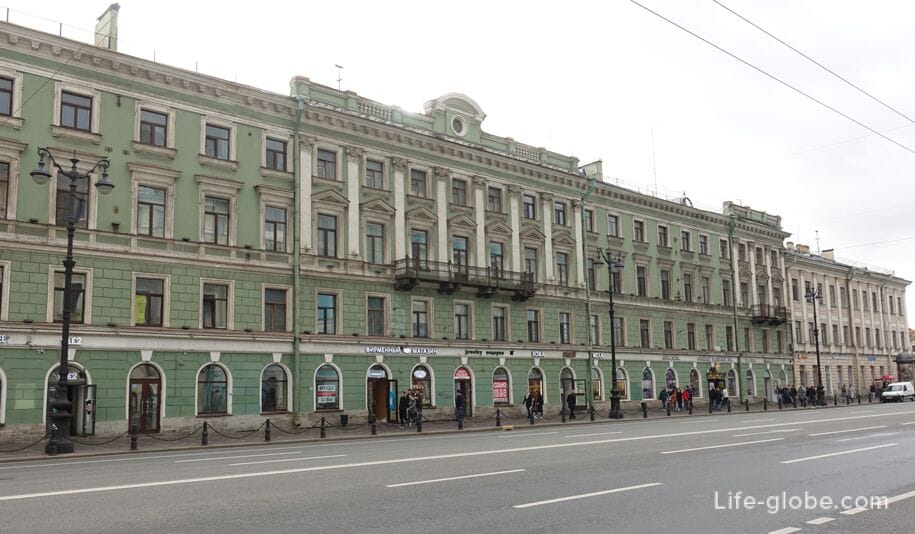
Engelhardt House (30 Nevsky Prospekt)
The history of the Engelhardt house dates back to the mid-18th century, when a 3-storey mansion was built for General Alexander Vilboa in 1759-1761.
Since 1828, the house belonged to the Engelhardt couple, for whom in 1829-1832 the building was rebuilt by the architect Paul Jacot in the late classicist style.
During its history, masquerades and concerts were held in the walls of the building. The best pianists of Russia and Europe, including Richard Wagner and Johann Strauss, performed here. Alexander Pushkin was also a frequent visitor.
Today, the building houses various commercial premises, cafes and restaurants, as well as the Small Hall of the Philharmonic Hall and the lobby of the Nevsky Prospekt metro station. More about the Engelhardt House…
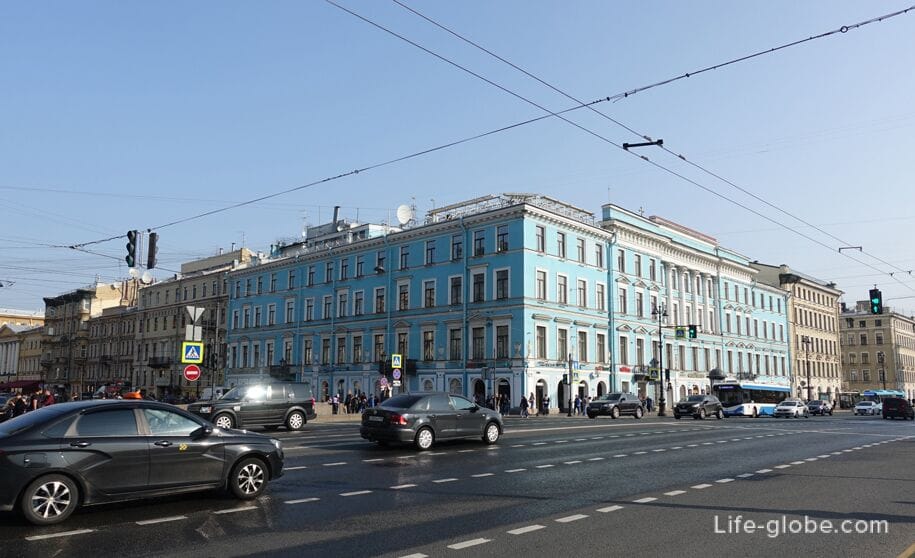
The City Duma building with a tower and Silver Rows (Nevsky Prospekt 31-33)
The building of the City Duma, the tower of the City Duma and the Silver Rows is a complex of buildings (buildings), which is an architectural monument of federal significance.
The City Council building was built as a Guild house in 1752-1754. Since 1786, the building also housed the St. Petersburg City Duma.
Next to the Guild House, in the same style, there were Silver Rows - trading rows for trading in silver and precious stones. The silver rows burned down in 1783. In 1784-1787, the architect Giacomo Quarenghi erected the stone building of the "Silver Rows"that has survived to this day.
In 1799, by the decree of the Emperor Paul I, the guild house was transferred to the city administration. At the same time, Paul I ordered the construction of a signal tower on the corner, in case of fire or flood - today it is the tower of the City Duma.
The City Council Tower is available for visiting. The most interesting thing in the tower is an open 360-degree observation deck, which, for a fee, can be climbed by a spiral staircase and from which one of the best opens in the city panoramic views of the center of St. Petersburg. Learn more about the complex of buildings…

Basilica of St. Catherine of Alexandria (Nevsky Prospekt 32-34)
The Basilica of St. Catherine of Alexandria is a Catholic church, which is the oldest in the city and one of the oldest churches of the Roman Catholic Church in Russia.
The church was built in 1763-1783 in the style of early classicism.
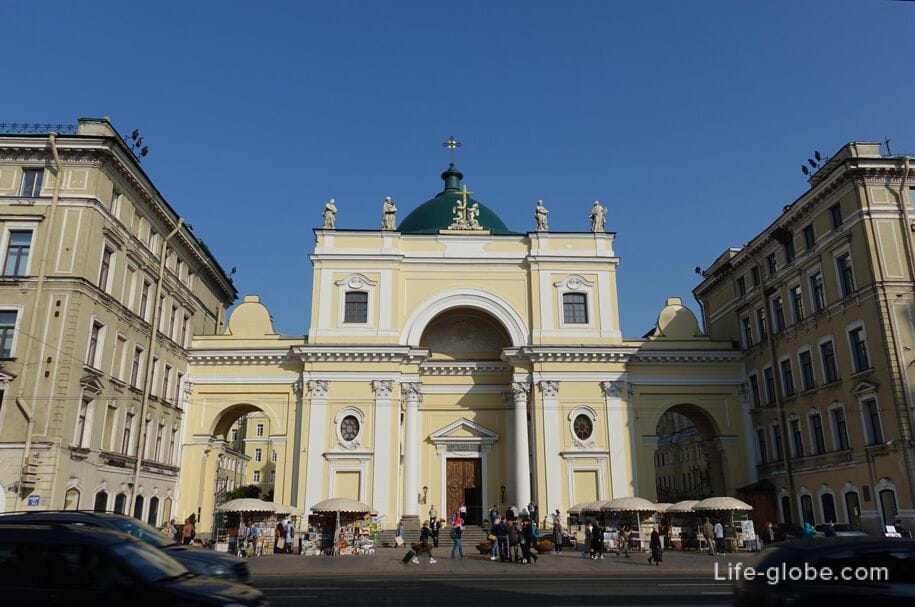
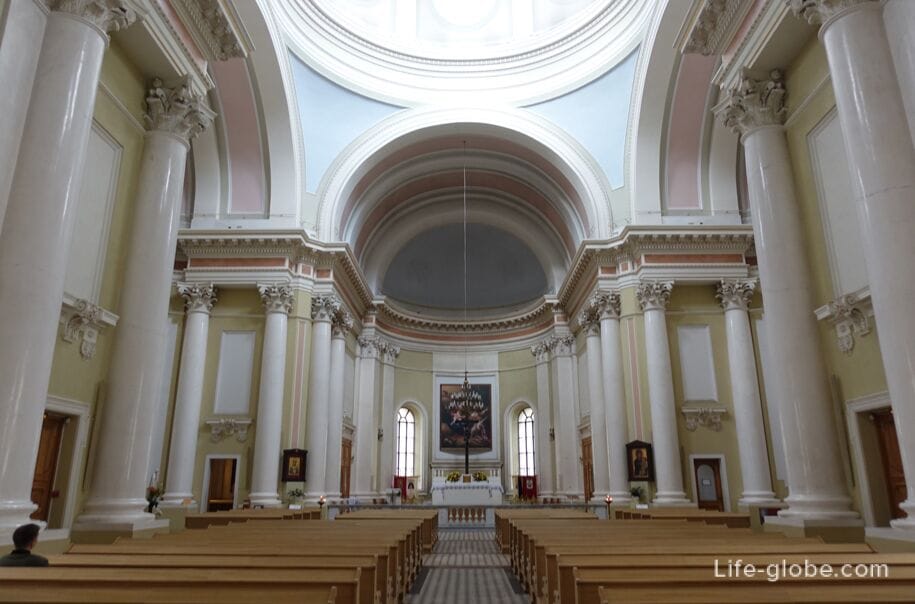
Adjacent to the basilica are two symmetrical former apartment buildings, designed by D. Trezzini and rebuilt in 1779 in the classical style by the architect A. Rinaldi.
The houses with the basilica are connected by arches.
In the houses you can stay: 4-star Grand Katarina Palace Hotel with concierge service, restaurant, free parking and free Wi - Fi; apartment-Nevsky 32 with 2 bedrooms, free Wi-Fi and parking; apartment PiterStay Nevsky 32 with 2 bedrooms, free Wi-Fi and parking. Learn more about the Basilica of St. Catherine of Alexandria...
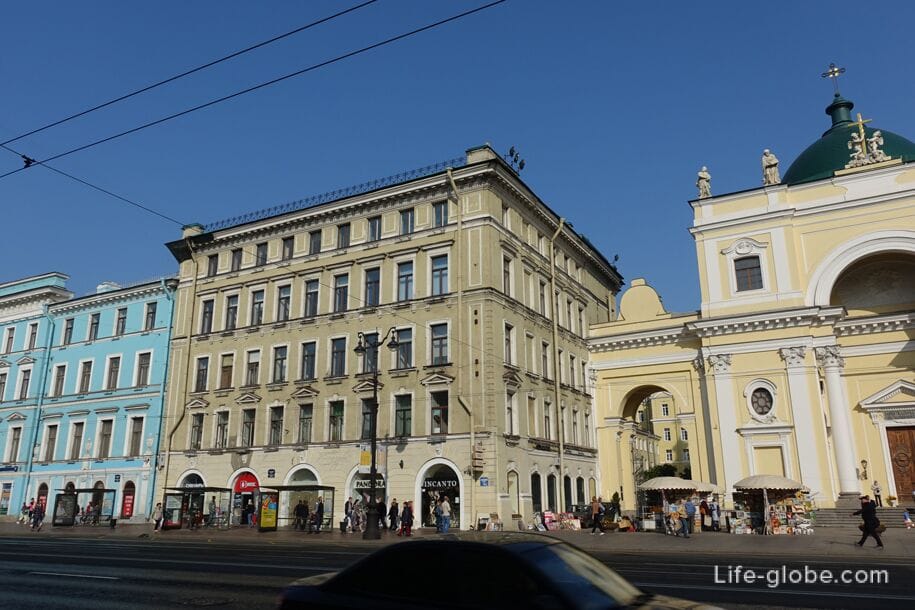
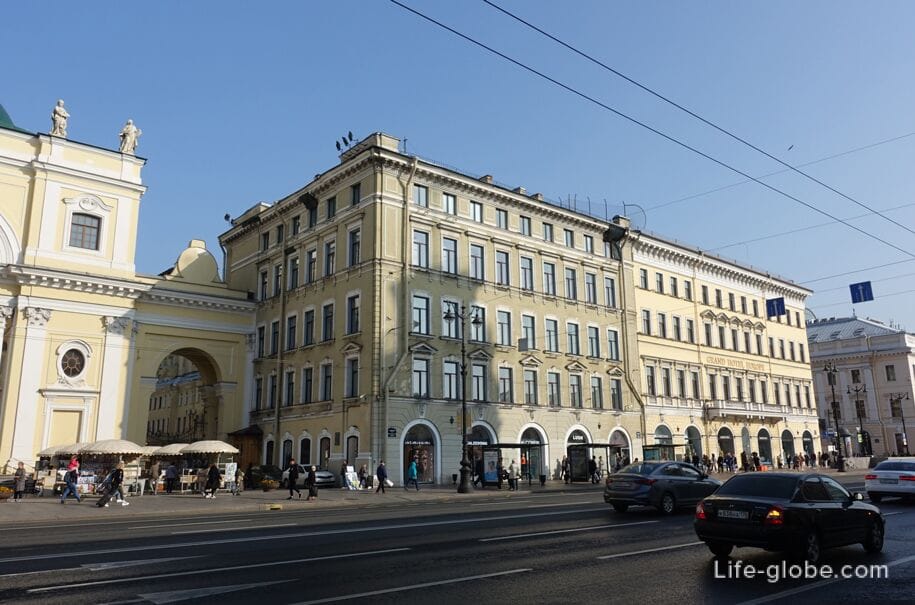
Bolshoy Gostiny Dvor (Nevsky Prospekt 35)
Bolshoy Gostiny Dvor is a historical shopping department store, which is a monument of history and architecture of the 18th century.
The history of Gostiny Dvor is closely connected with the formation of the city, when Gostiny Dvor was conceived by decree of the Empress Elizabeth Petrovna as the largest retail space in the Russian Empire.
Construction lasted from 1761 to 1785, designed by the French architect Jean-Baptiste-Michel Vallin-Delamotte, who built the building in the style of early classicism.
Subsequently, the facades of the Gostiny Dvor were modified.
During the Great Patriotic War, the building was badly damaged. In 1945-1948, the Gostiny Dvor was restored. The facades again took on a look close to the Delamotte plan, and a new pediment decorated with bas-reliefs was built over the main portico on Nevsky Prospekt.
Today, Bolshoy Gostiny Dvor, as well as many years ago, is a shopping place - the largest and most famous department store in the city. Learn more about Bolshoy Gostiny Dvor…
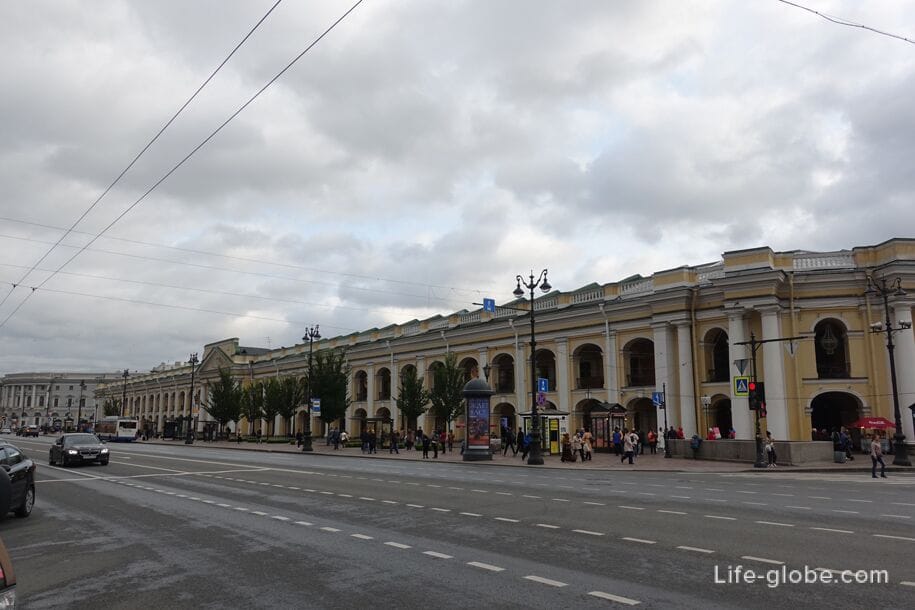
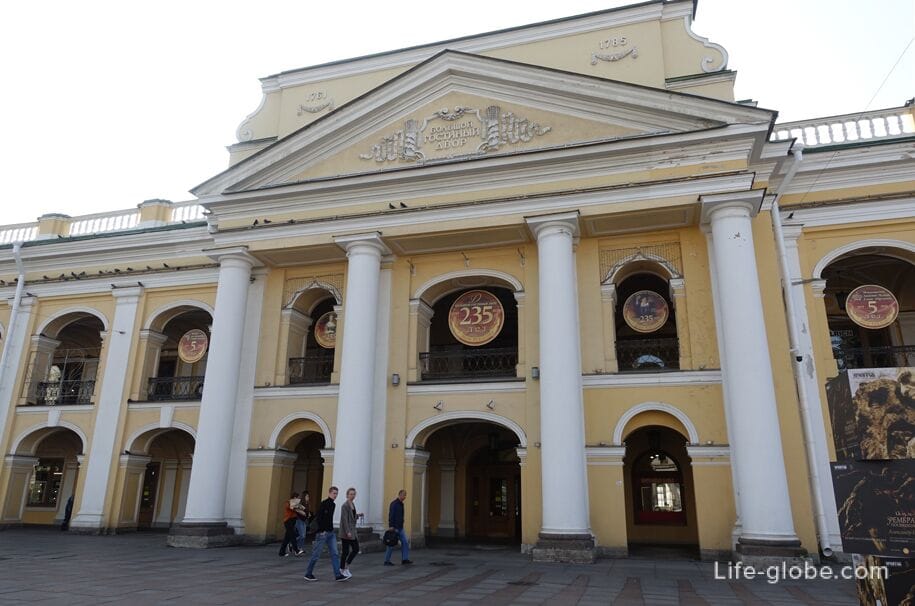
Grand Hotel (Nevsky Prospekt 36)
Belmond Grand Hotel Europe (Belmond Grand Hotel Europe) is a luxury hotel that is one of the best in the city, has 5 stars and is located in a historic building, the corner facade of which overlooks Nevsky Prospekt.
The building was built in the late 18th century. In 1823-1825, the old house was rebuilt and new stone houses were built on the site. Another reconstruction, designed by K. I. Rossi, took place in 1826-1830.
In the second half of the 19th century, the buildings were converted into a hotel, in an eclectic style. Subsequent alterations, superstructures and redevelopments of the building were also carried out. The building was used for various purposes, until in 1945, after repairs, it began to function again as a hotel.
Today, within the walls of this historic vast building, 5-star "Belmond Grand Hotel Europe" (link to the hotel).
Hotel facilities: Concierge, bar, fitness center, spa and wellness center, free Wi-Fi and parking, facilities for disabled guests, travel desk, ATM and conference halls.
The hotel rooms are equipped with all modern amenities, including satellite TV, mini-bar, safe and air conditioning. The private bathroom is equipped with bathrobes, slippers, a hairdryer and free toiletries.
A buffet breakfast can be included in the room rate. Link to the hotel
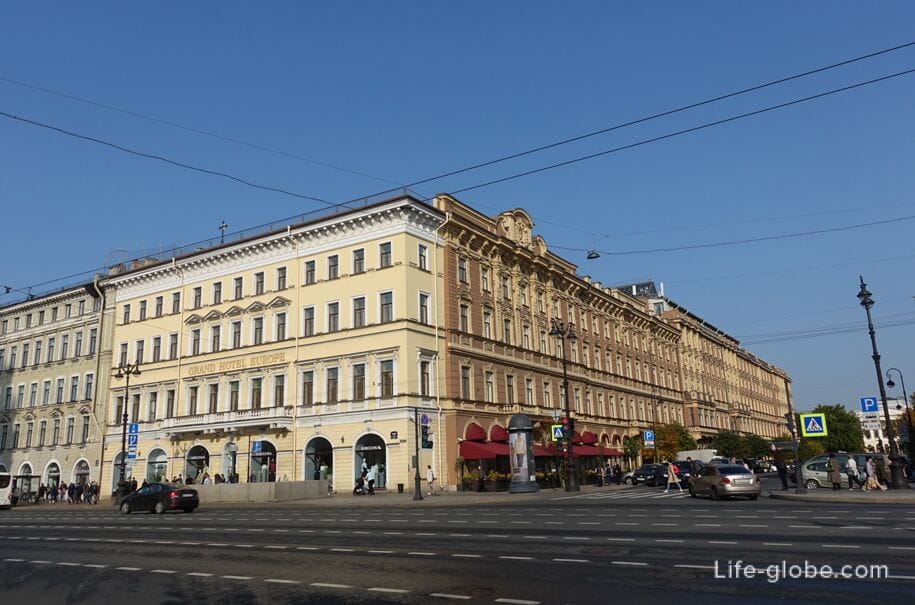
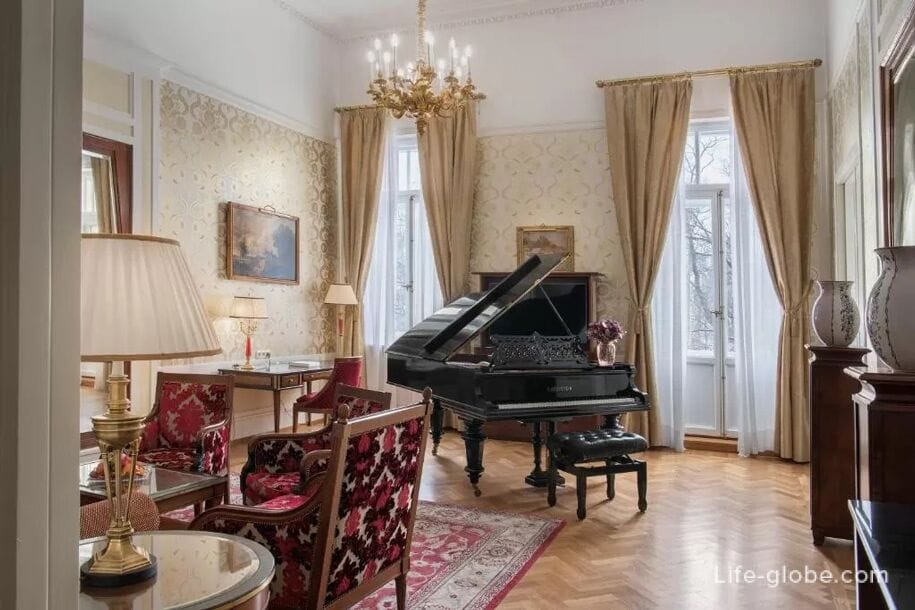
Stroganov House (38 Nevsky Prospekt)
The Stroganov House (Volga-Kama Commercial Bank) was rebuilt in 1834-1839 in the classical style by the architect P. P. Jaco (designed by Rossi) for Countess Stroganova.
Since 1881, the building housed the board of the Volga-Kama Commercial Bank, for which the architect G. B. Prang converted the first floor of the building.
Subsequently, the building was completed and expanded.
In 1948, the facade of the building was restored by the architect I. G. Kaptsyug, and the appearance of the house became closer to the original plan of Rossi. In the 1990s, the building was transferred to the Industrial Construction Bank. Since 2004, there has been a business center with an extensive atrium.
The building has a side facade facing Nevsky Prospekt. The main facade faces Mikhailovskaya Street.
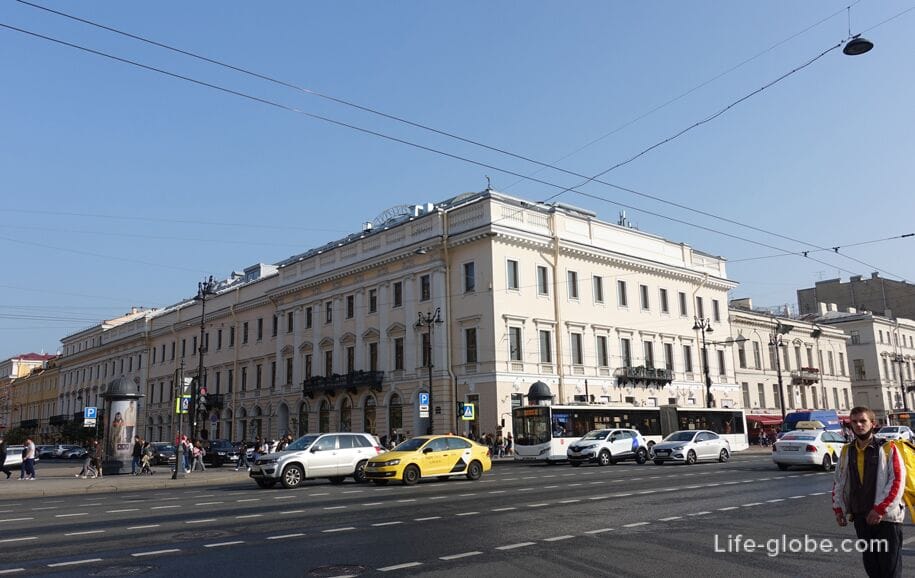
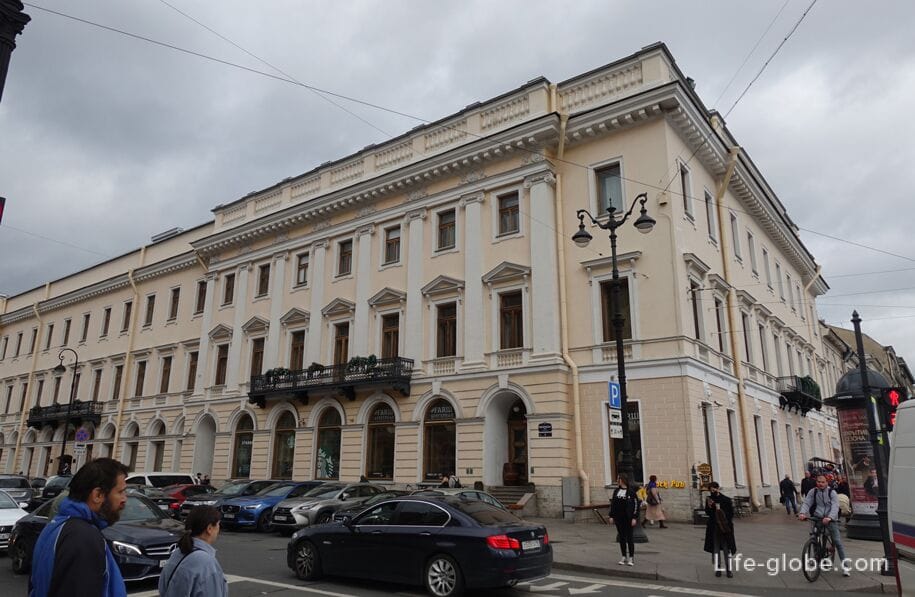
Armenian Apostolic Church of St. Catherine (Nevsky Prospekt 40-42)
St. Catherine's Church (Armenian: Սանկտ Պետերբուրգի Սուրբ Կատարինե եկեղեցի) is a church of the Armenian Apostolic Church in St. Petersburg, which is an architectural monument.
The church was built in 1771-1779 by architect Yuri Matveevich Felten.
The style of the church is made in the traditions of early Russian classicism.
The main facade of the church faces Nevsky Prospekt (to the south) and is marked by a strict columned portico, in the pediment of which there is a sculptural relief with a story from the history of Armenia: "Catholicos Grigor the Illuminator performs the baptism of King Trdat III".
The facade of the church is also distinguished by the architectural decoration of the windows, pilasters with elegant capitals and a towering domed tower with a cross.
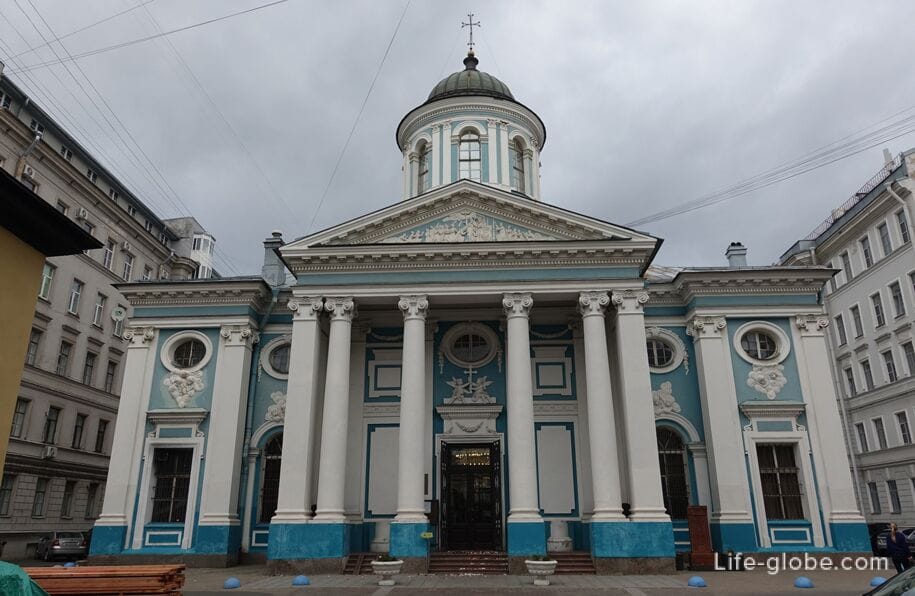
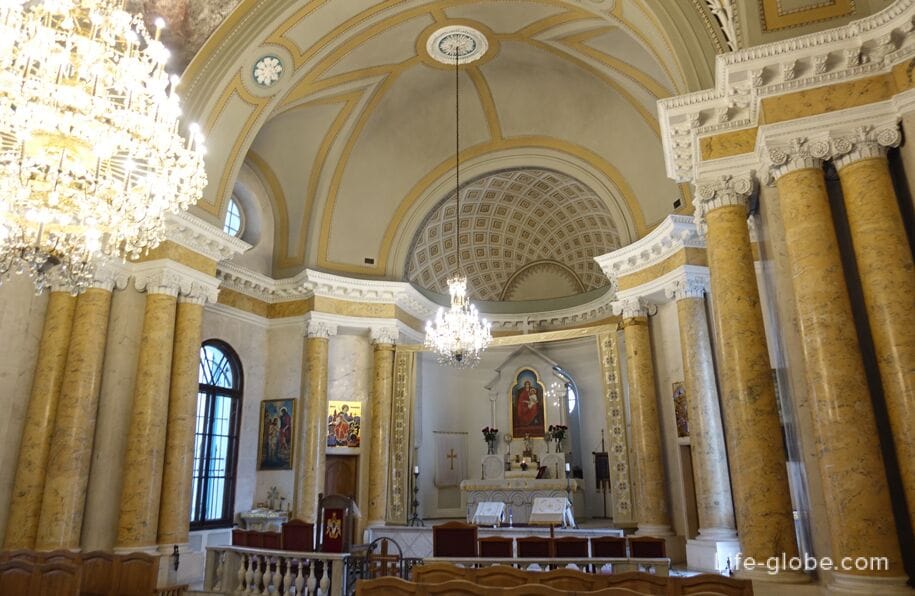
An ensemble of buildings of the Armenian community is formed around the church:
- the building on Nevsky Prospekt at number 42 was built according to the project of Yu. M. Felten as the house of the head of the Armenian community - Ivan Lazarevich Lazarev;
- the second residential building at number 40 at the church was built in 1794-1798 by the architect Yegor Timofeevich Sokolov also for Lazarev.
In the future, both houses were restored, and the house at number 42 was rebuilt according to the project of A. I. Melnikov - one floor was added.
Currently, the Culture Committee of the Administration of St. Petersburg is working in the house No. 40. Commercial premises are also located in the houses.
The house offers accommodation in Nevsky 40, a one-bedroom apartment with city views, free private parking and Wi-Fi. Learn more about the complex of the Armenian Church of St. Catherine…


Grand Palace (Nevsky Prospekt 44)
The Grand Palace (formerly the Siberian Merchant Bank building) is a historic building that today houses the Grand Palace Boutique Gallery.
The first three-storey house on this site was built in 1778 for the valet N. S. Kozlov. In 1779, the house was added to the fourth floor, and in 1858-the fifth.
In the 1880s-1900s, the site belonged to the insurance company "Russia".
In 1907, the building came into the possession of the Siberian Merchant Bank, for which it was completely rebuilt.
In Soviet times, various institutions and cafes worked in the building.
From 2003 to the present, the building houses the Grand Palace Boutique Gallery, which, in addition to boutiques, has a cinema, a beauty salon, a restaurant and a cafe.
Featuring free Wi-Fi, free private parking, a fitness centre and a 24-hour front desk, Majestic apartment on Nevsky, 44 offers self-catering accommodation. Learn more about the Grand Palace Gallery»…
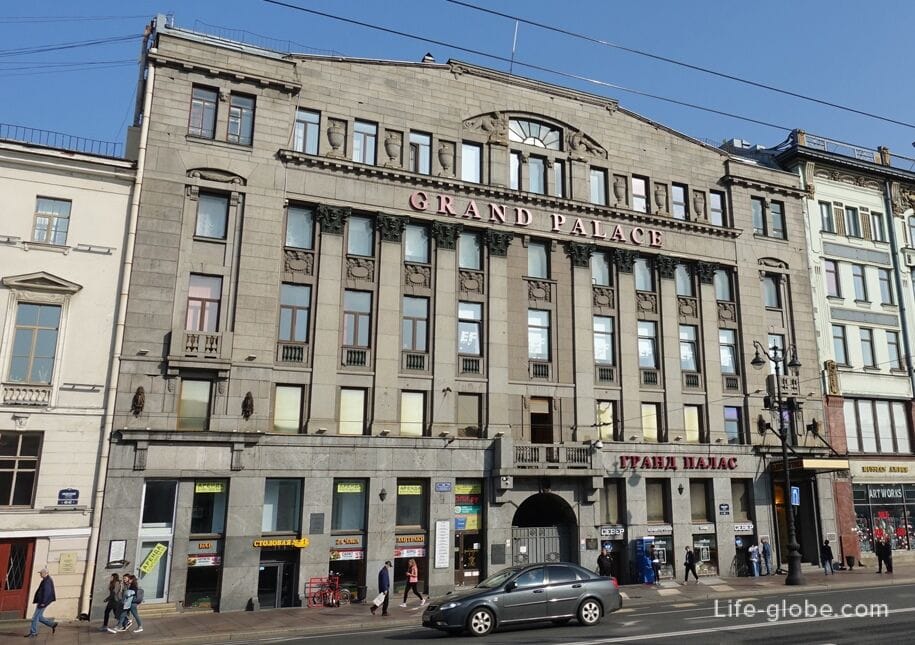
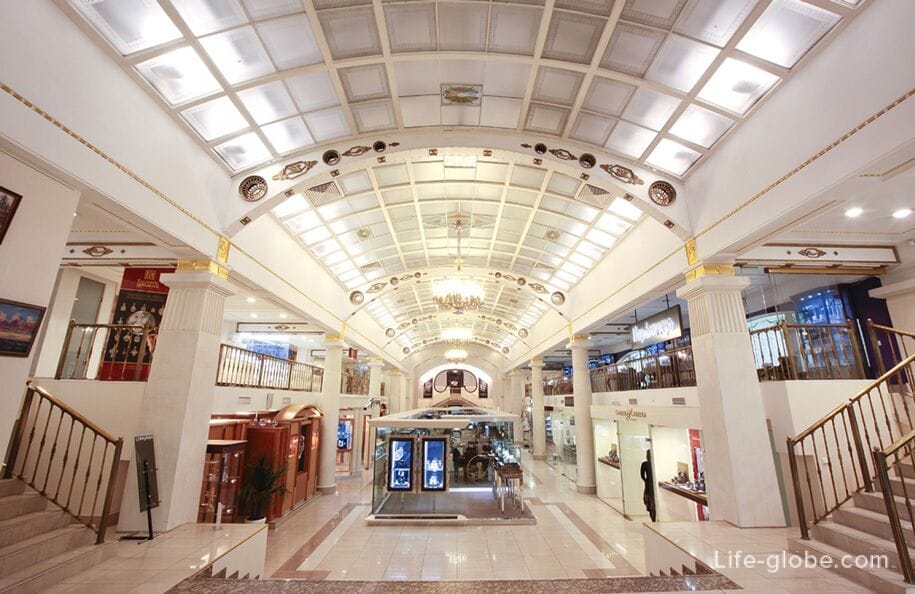
Moscow Merchant Bank (Nevsky Prospekt 46)
The house on this plot was built in 1745-1746 by the architect M. G. Zemtsov for the coffeeshop of the Empress Elizabeth Petrovna-Alexander Ulyanovich Sablukov.
Subsequently, the owners of the house changed, and the building was rebuilt.
The current building was built in 1901-1902 by the architect Leontius (Ludwig) Nikolayevich Benois for the St. Petersburg branch of the Moscow Merchant Bank.
The house of the Moscow Merchant Bank was the first building in the Art Nouveau style on Nevsky Prospekt. The bank occupied the upper floors of the building, and rented out the first floors.
Currently, as many years ago, the building has a Dental clinic No. 1 and a large store of the book retail chain "Bukvoed".
The building is designed in the style of South Slavic Art Nouveau. Read more about the building of the Moscow Merchant Bank…
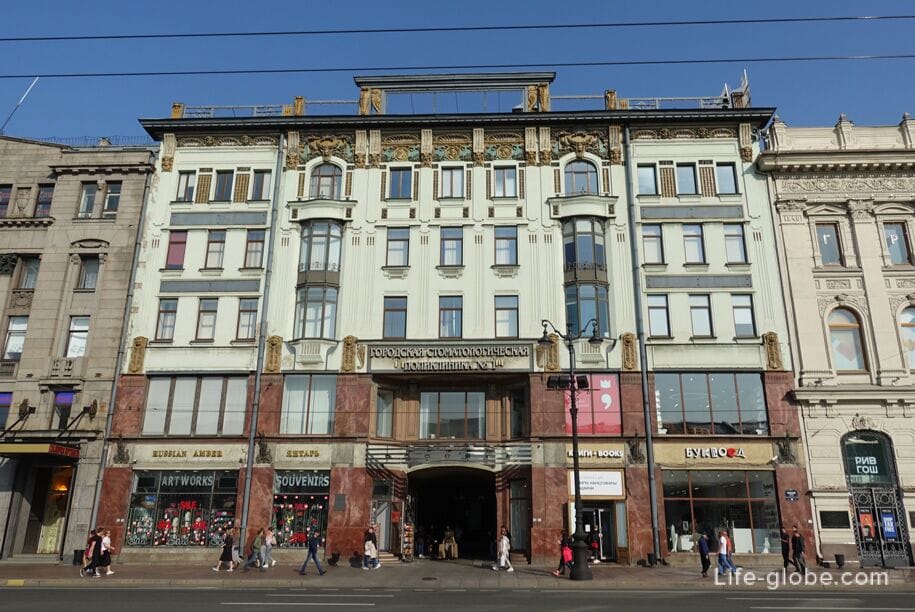
Passage (Nevsky Prospekt 48)
Passage is a historical shopping house (shopping gallery), which is one of the oldest and largest shopping centers in St. Petersburg.
The building was built by order of the then owner of the land plot - the collegiate councilor Count Yakov Ivanovich Essen-Stenbock-Fermor, designed by architect Rudolf Andreevich Zhelyazevich in 1846-1848, not only as a trading house, but also as a center of cultural and social life of the capital.
The three-tier shopping house "Passage" first opened its doors in May 1848.
In the late 18th and early 19th centuries, the building was rebuilt by architect Sergei Kozlov at the behest of its new owner, Princess N. A. Baryatinskaya. The passage became four-storeyed, and the entrance two-column portico was added to the main facade facing Nevsky Prospekt.
Today, the Passage is a well-known shopping center, within the walls of which there are shops, salons, boutiques, cafes and restaurants. Learn more about the Passage…
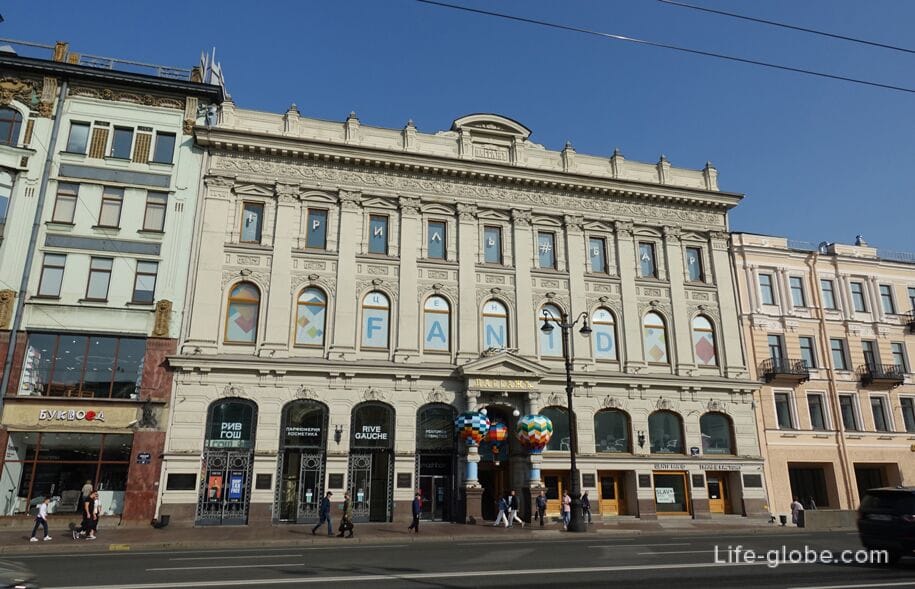
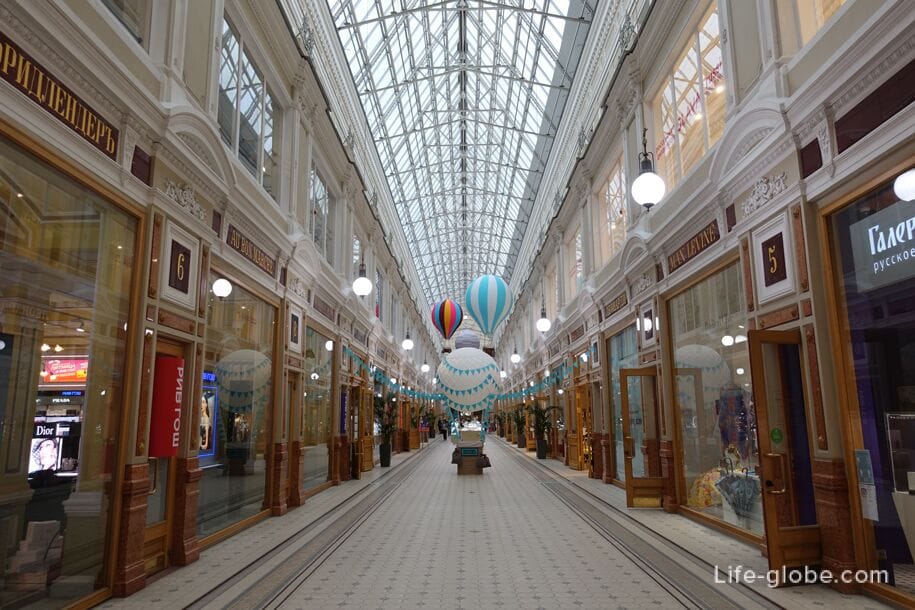
Kusova House (50 Nevsky Prospekt)
The residential building on this site was built in 1744 according to the model design of the architect M. G. Zemtsov.
At the end of the 18th century, there was a three-story building on the site, made in the style of early classicism. In the first half of the 19th century, the merchant P. Paskov-Sharapov owned the house, and his heirs owned the post. When they were in the building, the first homeopathic pharmacy in Russia worked (since 1833).
Since 1876, the house was owned by Baroness A. P. Kusova, for whom the fourth floor of the building was built according to the project of architect A. A. Shchedrin, and the facade was re-glazed and decorated in the eclectic style.
Subsequently, in different periods, various editorial offices, publishing houses, organizations, the Majestic cinema and shops worked in the building.
In the 1960s, an exit from an underground pedestrian crossing was built next to the house; for the convenience of pedestrians, the first floor of the building on Nevsky Prospekt became an open gallery.
The building includes commercial premises and the 3-star Sapphire Hotel, which offers family rooms, a shared lounge, free Wi-Fi and breakfast included in the room rate.
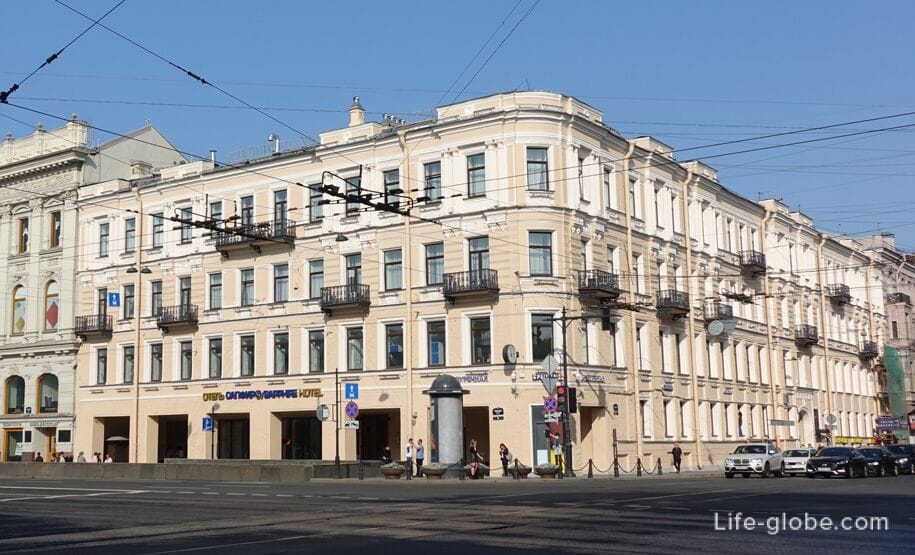
Russian National Library (37 Nevsky Prospekt)
The Russian National Library (RNB) is one of the first public libraries in Eastern Europe and the oldest national library in Russia, consisting of several buildings in St. Petersburg.
Initially, in 1796-1801, on the corner of Nevsky Prospekt and Sadovaya Street, the architect Yegor Sokolov designed the first special building in Russia designed to house a library.
By 1832, according to the project of Rossi, a building was added to the existing Sokolov building on the side of Ostrovsky Square, which was called "Rossi" and thus created a harmonious whole structure.
Today, these buildings are part of the main library complex. Learn more about the Russian National Library…
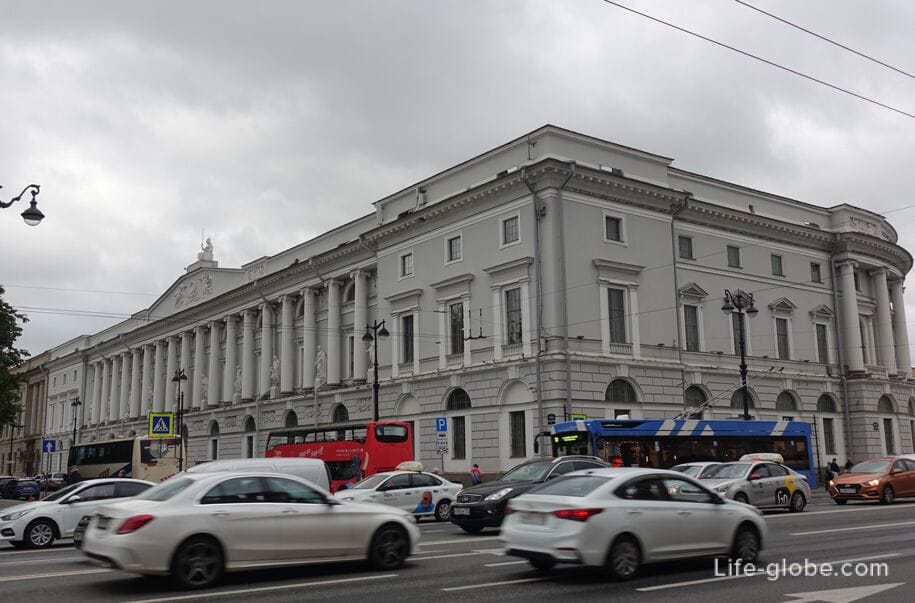
Ostrovsky Square
The history of the square dates back to the mid-18th century, when the land of the Anichkov Palace was listed on this place.
The formation of a full-fledged square began with the construction of the nearby Alexandrinsky Theater (1832) - when part of the land of the palace (the western part of the garden) was allocated as a separate unit for the arrangement of the territory in front of the theater.
Today, Ostrovsky Square is an architectural complex that remains one of the highest achievements of Russian urban planning art.
On the square there are: Catherine's Garden with a monumental monument to Catherine II, Alexandrinsky Theater with a museum, buildings of the Ministry of Public Education and the Directorate of the Imperial Theaters, the house of Basin, the building of the city credit society, the building of the Russian Musical Society, the monument to the janitor, etc.
On the west side of the square stands the building of the Russian National Library, and on the east-the square is bordered by the garden of the Anichkov Palace. Learn more about Ostrovsky Square…
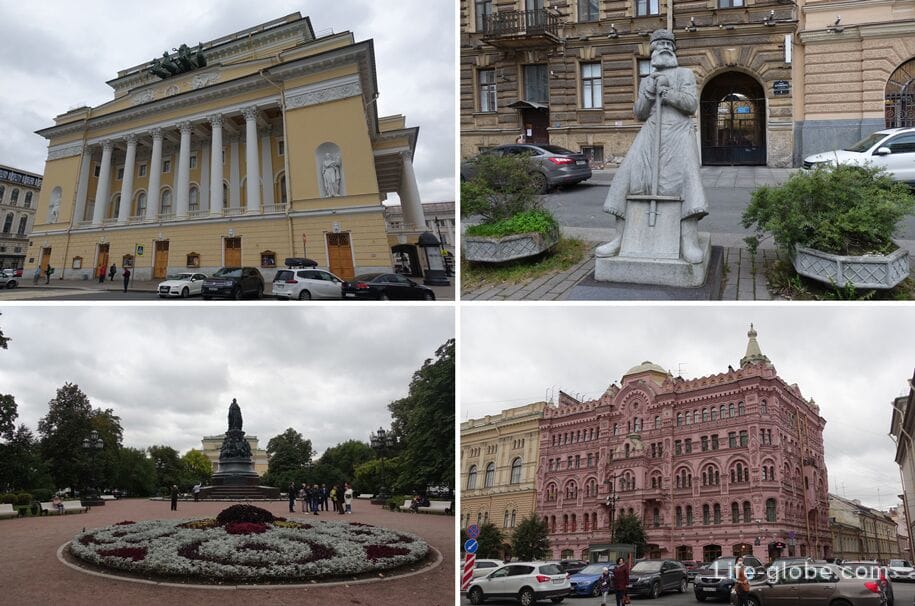
Anichkov Palace (39 Nevsky Prospekt)
Anichkov Palace - one of the former imperial palaces-now a monument of Russian architecture of the 17th and 19th centuries.
The palace was erected starting in 1741 by the decree of the Empress Elizabeth Petrovna.
In the garden of the Anichkov Palace there are two pavilions built by K. I. Rossi in 1817-1818.
The palace itself consists of several buildings, which today are: the theater and concert complex "Carnival", the St. Petersburg City Palace of Youth Creativity, the library and the Anichkov Lyceum.
Sightseeing tours are held in the palace. Concerts, evenings and holidays are also held.
The Anichkov Palace complex is located between Ostrovsky Square, Nevsky Prospekt, which overlooks the former Office of His Imperial Majesty, and the Fontanka River embankment. Learn more about Anichkov Palace and Garden…
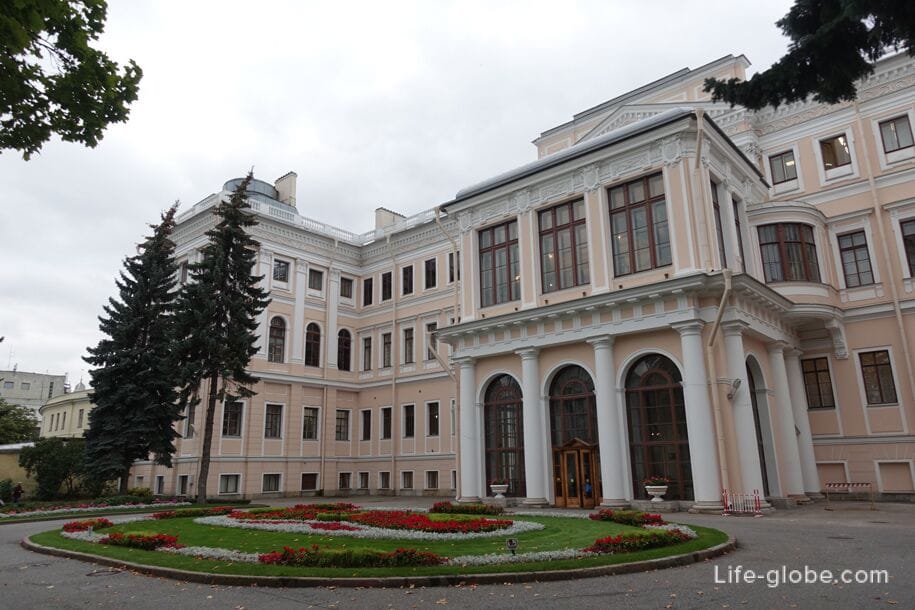

View of the palace from Nevsky Prospekt
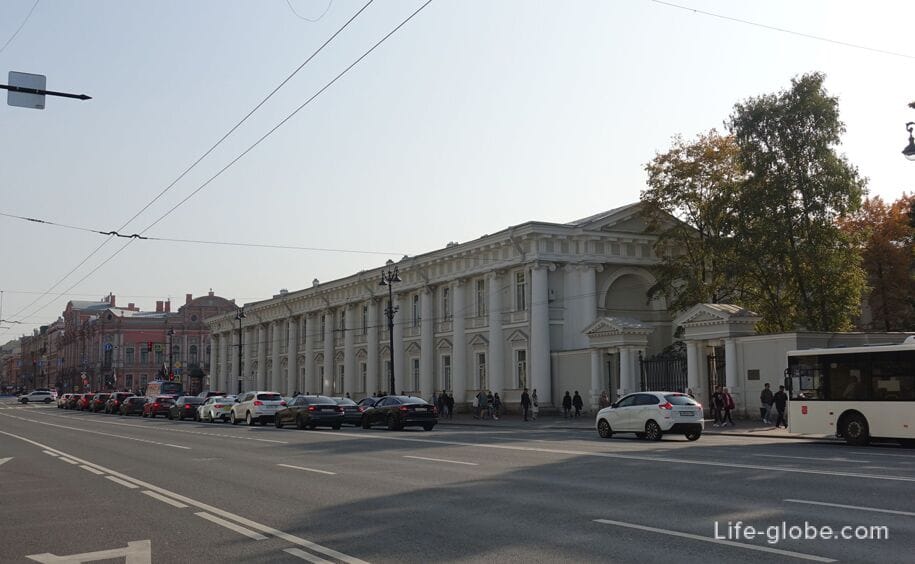
Borozdina House (52 Nevsky Prospekt)
The house on this plot was built in the 1740s for the Ostashkovsky philistine S. Ya. Yakovlev (Sobakin) according to the standard design of the architect M. G. Zemtsov. Since 1740, Zemtsov has built up the entire northern side of Nevsky Prospekt with such model houses - from Moika to Malaya Sadovaya Street.
Since 1787, the house belonged to N. A. Borozdina, for whom a three-story house with a strict classical facade was built. The main hall of the Borozdina house was rented out for an exhibition of wax figures.
In 1797, the building was purchased by the treasury, and it housed the Theater Directorate and the Theater School.
In 1814, the house was purchased by the "case master" Richter. The house also had a tavern, a furniture store of K. A. Tura, at whose factory, according to the sketches of the architect Rossi, furniture was made for Elagin and Mikhailovsky palaces.
In 1850, Richter's heirs rebuilt the house according to the design of B. B. Heydenreich.
Subsequently, the owners and tenants of the premises in the house changed. Some of the residential premises were rented out, and some were intended for commerce, including a concert hall.
In 1937, the house housed the Demmeni Puppet Theater, which was the first professional puppet theater in Russia and was named after its creator, an actor and director who led the theater from 1924 to 1969. Now the theater is still located in the house, but it is called the "Marionette Theater named after E. S. Demmeni". Website of the theater: demmeni.
This corner building, like the building on Nevsky Prospekt No. 50, faces Nevsky Prospekt and Sadovaya Street. And, as well as next to the house at number 50, an exit from the underground pedestrian crossing was built next to this house; for the convenience of pedestrians, the first floor of the building on Nevsky Prospekt became an open gallery.
Apartment on the Nevsky is a one-bedroom apartment with air conditioning, heating, free Wi-Fi and a 24-hour front desk.
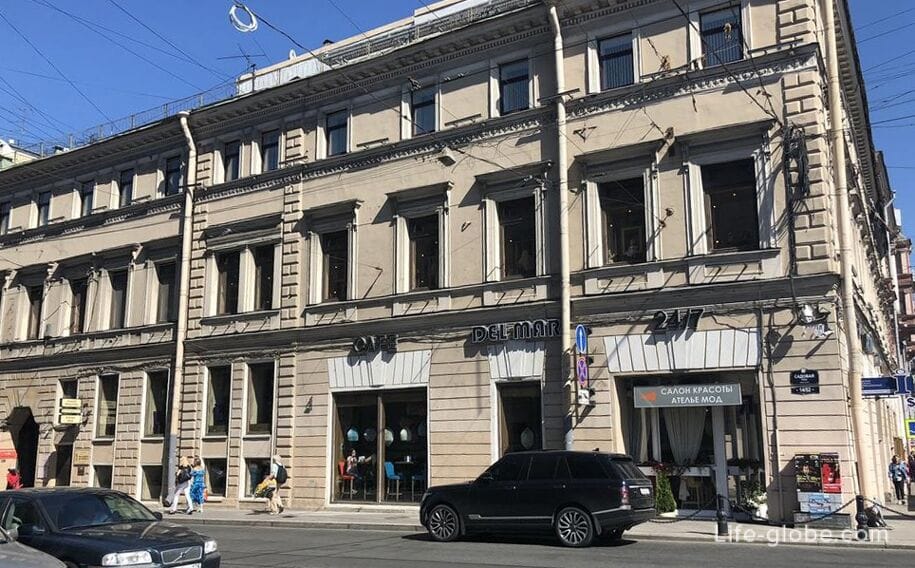
Ushakov House / Karl Bulla Museum-photo salon (Nevsky Prospekt, 54)
At the corner of Nevsky Prospekt 54 and Malaya Sadovaya Street 3 is an exquisite historical building, which during the history was rebuilt and changed owners, among whom were: Count I. I. Shuvalov; millionaire industrialist N. N. Demidov and a major entrepreneur A.M. Ushakov (and his heirs), for whom in 1882-1883, according to the project of P. Yu.Suzor, the building was rebuilt in the form in which it exists today.
The building has an eclectic facade, decorated with architectural elements, stucco, bay windows, semi-columns and pilasters with capitals.
Most of all, the building is known as the "Karl Bulla Photo Salon" - one of the oldest private photo salons in Russia, which was located in this house.
Today, the photo salon houses the Karl Bulla Memorial Museum, which houses:
- exhibition gallery;
- a balcony with views of Nevsky Prospekt, Ostrovsky Square and the surrounding area;
- archive of historical photographs of the famous St. Petersburg photoletographer Karl Bulla and sons;
- bookstore.
The museum-photo salon also hosts exhibitions, lectures, meetings with authors and master classes.
In the house you can stay: apartment ERS on Malaya Sadovaya with 2 bedrooms, free Wi-Fi, air conditioning and a hot tub; apartment ERS Nevsky with 2 bedrooms, free Wi-Fi and air conditioning. Read more about the Karl Bulla House and Museum-photo salon…

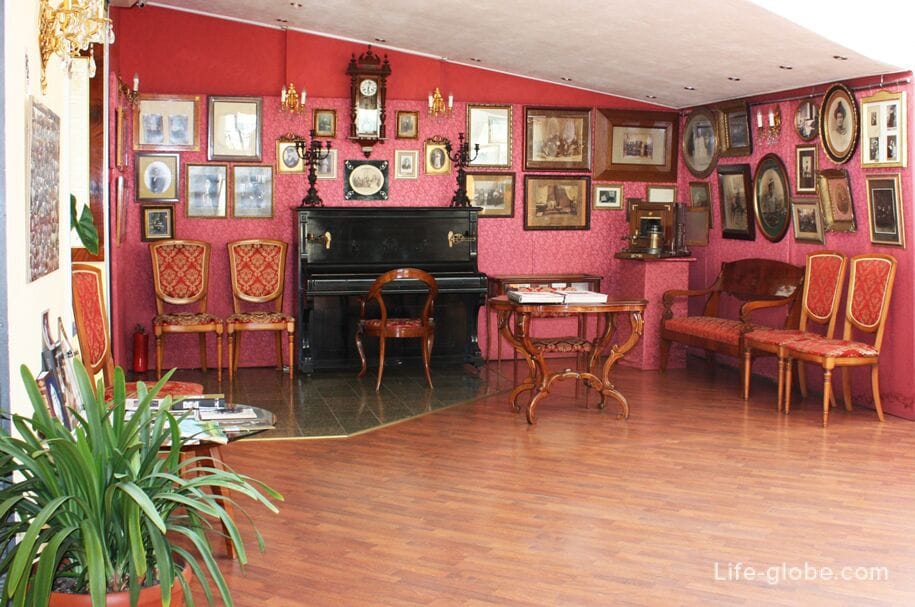
Malaya Sadovaya Street
Nevsky Prospekt is adjacent to one of the most beautiful streets of the city - Malaya Sadovaya, which is completely pedestrian.
Along the street, on both sides, there are dense rows of historical buildings, which are located, including museums, shops, cafes and restaurants with open-air tables.
The street is also decorated with tubs of flowers, lanterns, a fountain, monuments and sculptures.
On the street are notable: fountain "Rotating ball" (fountain-clock)which is said to grant wishes; the monument to the cat and the cat; the monument to the St. Petersburg photographer; the radio house, the house of Armyaninov and the house of Shuvalov, which houses the museum of hygiene. Learn more about Malaya Sadovaya Street…
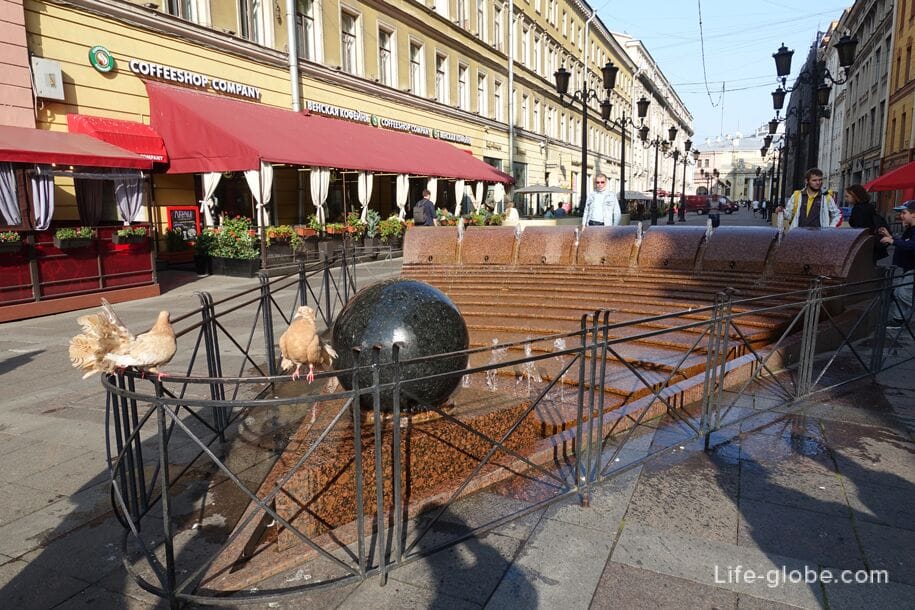
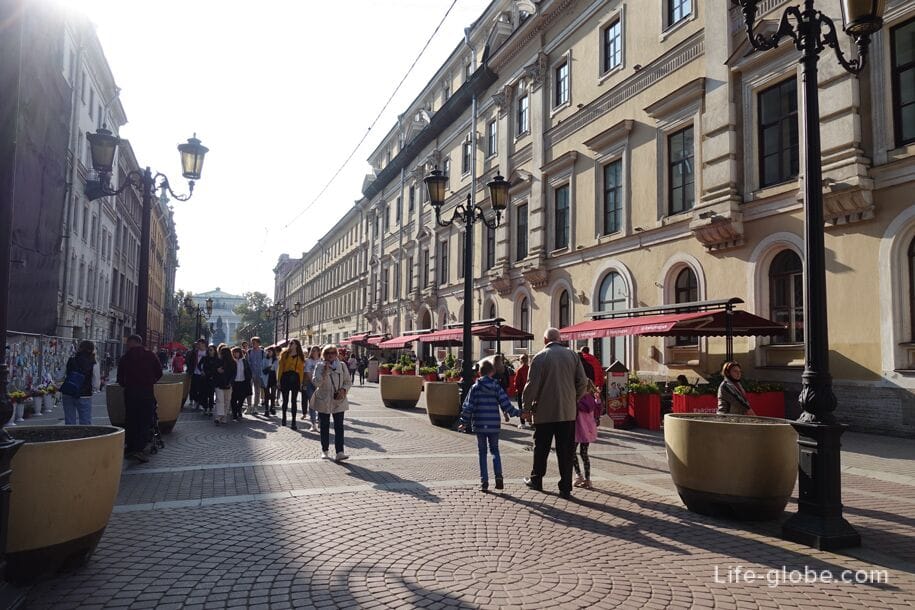
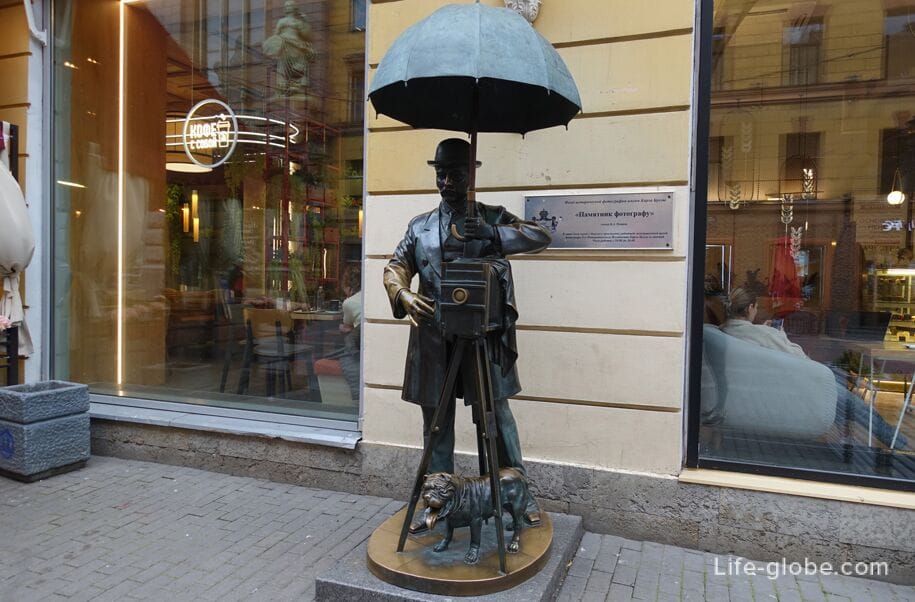
Shop of merchants Eliseevs (Nevsky Prospekt 56)
At the corner of Nevsky Prospekt 56 and Malaya Sadovaya Street, there is one of the most impressive buildings in St. Petersburg - the shop of the merchants Eliseevs or the Eliseevsky Shop.
The building was built in 1902-1903 according to the project of the architect Gavriil Vasilyevich Baranovsky for the store of colonial goods of the trade association "Brothers Eliseev". The Yeliseyevs are a dynasty of merchants, entrepreneurs, and public figures.
The style of the entire building is modern with elements of eclecticism and classicism.
The building has large windows and powerful pylons, and its facades are decorated with sculptures, plant elements, ornaments and openwork lattice.
Today, within the walls of the building are located: the shop of merchants Eliseev with an elegant interior and a small coffee shop, as well as the Comedy Theater named after N.P. Akimov. Read more about the merchant Eliseev store…
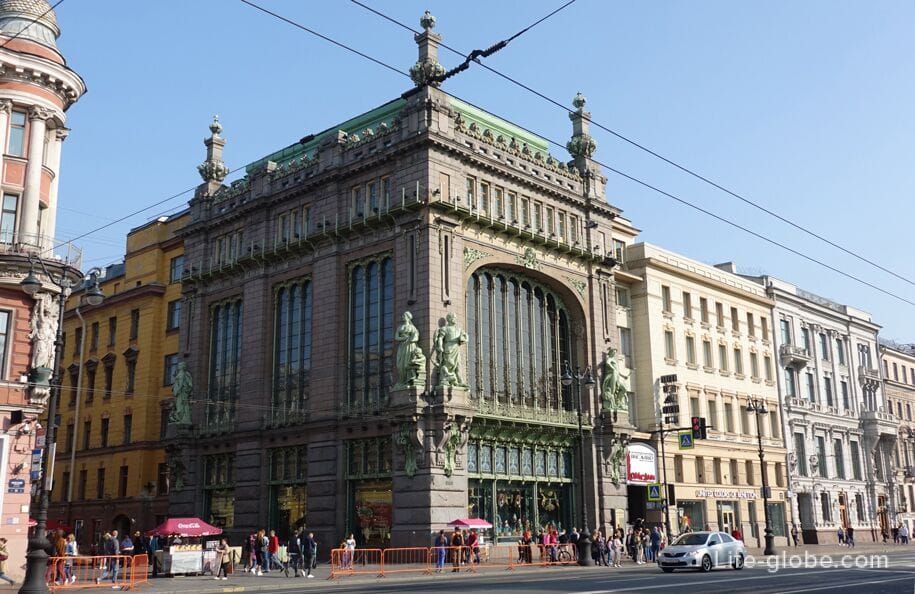
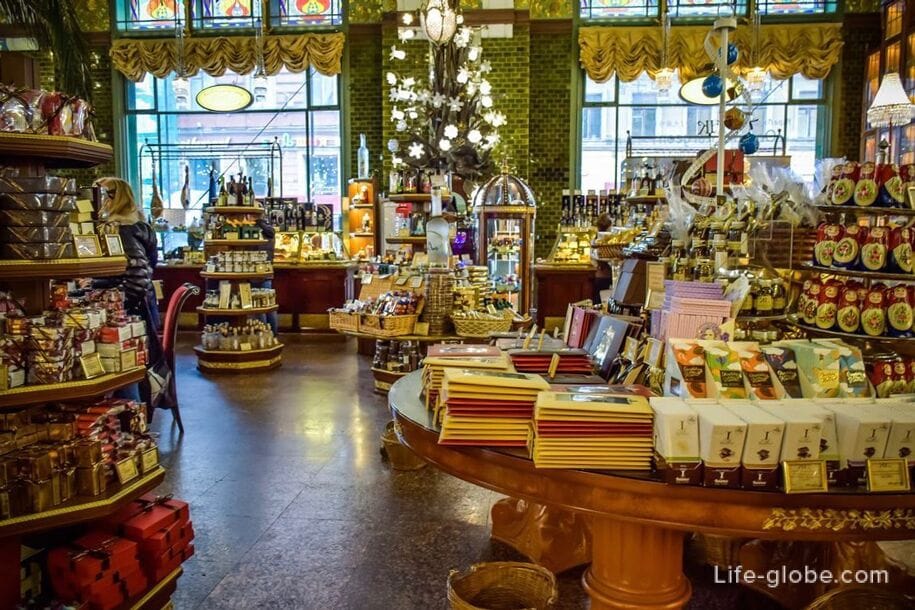
International Commercial Bank (Nevsky Prospekt 58)
The International Commercial Bank purchased the site in 1896, on which by 1898 an eclectic style building was built, designed by architect S. A. Brzozovsky and with the participation of engineer S. I. Kerbedz.
The facade of the building is decorated with pilasters with capitals and in the upper part is lined with light gray dolomite marble. The house is decorated with small architectural balconies, as well as a risalit for the entire height of the building.
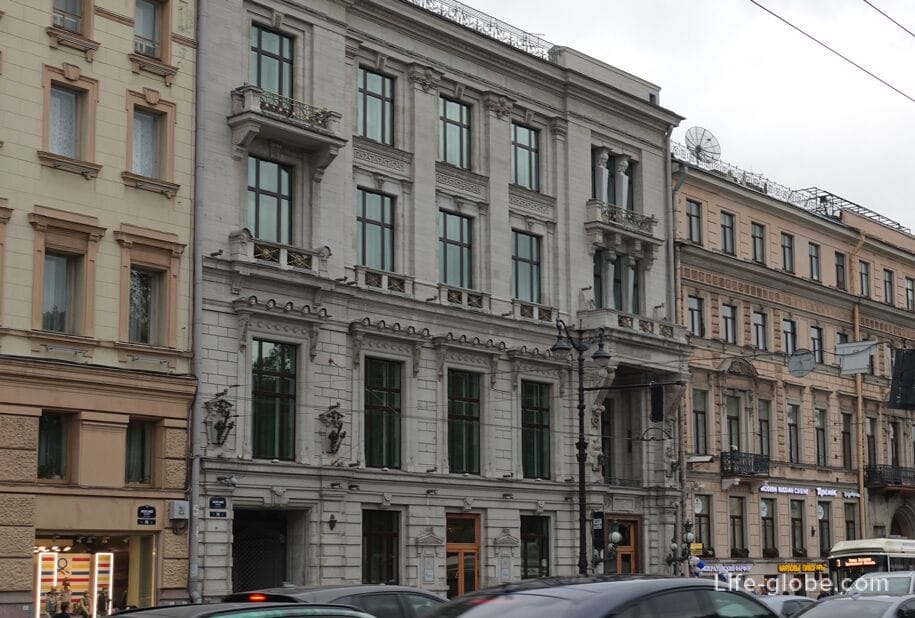
Glazunov House (Nevsky Prospekt 60)
The building on this site was built in the 1770s for the merchant I. Yu. Denisov and was a two-story stone house.
Subsequently, the house was ownedby Count S. P. Rumyantsev, then his daughter-Princess V. S. Golitsyn and Countess A. A. Tolstaya, for whom the architect G. E. Bosse developed a project for rebuilding the house into a mansion, with a facade in a magnificent Baroque style.
Since 1858, the plot was owned by the merchant and honorary citizen I. I. Glazunov, for whom the architect E. I. Vintelgalter built the building and changed the facade.
In the 1910s, the house belonged to the hereditary honorary citizen A.V. Glazunov. In 1913, a building for the Piccadilly cinema was built in the courtyard, designed by engineer N. P. Stepanov and architect V. V. Shaub, which became one of the first large cinema halls in St. Petersburg and could accommodate 700 spectators. Then the cinema was called "Aurora" and the cinema hall was expanded.
The Russian Fairy Tale Apartment offers a bedroom, free Wi-Fi and free parking.
The building of the St. Petersburg-Azov Commercial Bank (Nevsky Prospekt 62)
The site was purchased by the St. Petersburg-Azov Commercial Bank in 1895. In 1898, a new building was built for the bank, designed by architect B. I. Girshovich.
In 1902, the St. Petersburg-Azov Commercial Bank went bankrupt, and the building passed to the Northern Bank (since 1910 - to the Russian-Azov Bank).
The facade of the building is designed in the style of late classicist eclecticism, faced with Radom sandstone, richly decorated with pilasters with capitals, arched and paired windows. The left risalit of the building is completed with a high "Baroque" attic with volutes and a bow pediment, in which the mask of Mercury is placed.
In the photo, houses 60 and 62 on Nevsky Prospekt

Menshikov House (Nevsky Prospekt 64)
A profitable three-storey house with a classic facade was built on this site in the 1780s for the merchant Zhadimirovsky.
In the 1790s, the house was purchased by the Menshikov noble family, for whom in 1881-1882 the building was rebuilt according to the plan of the architect V. A. Prussakov: the house was built on two floors, and three-sided bay windows appeared on the facade. At that time, the living quarters in the house were rented out, and the commercial premises were located below.
Today, this three-dimensional building with a rounded corner facade, bay windows, discreet architectural decorations, attics and small rare balconies with openwork railings, really attracts attention, both with a perfect combination of colors and a harmonious fit into the structure of the buildings on Nevsky Prospekt.
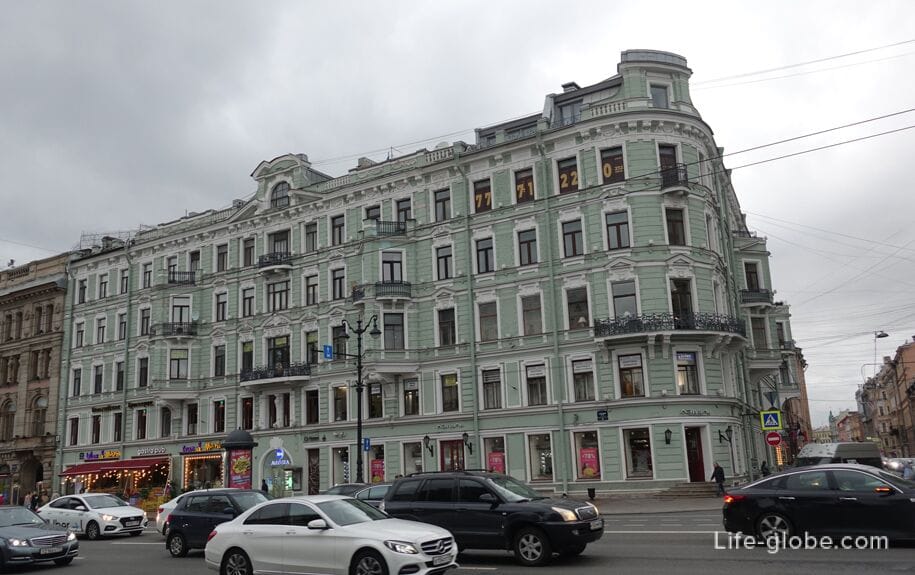
Merchant Sharov's House / Likhachev's House (Nevsky Prospekt 66)
Originally on this site in the 1720s there was a wooden guardhouse guarding the drawbridge Anichkov bridge - at that time there was a city border.
The three-storey stone house with a classical facade was built in 1799-1806 for the merchant P. I. Sharov.
In 1877-1878, the new landlord P. I. Likhachev rebuilt the house according to the project of the architect Alexander Vasilyevich Ivanov, as a result of which the house became five-story and intended for renting furnished rooms. After the reconstruction, the building has acquired a modern eclectic look.
In the architecture of the facades of the house thereare : rustics, shovels and pilasters, a variety of architraves, a magnificent frieze and many stucco details, as well as bay windows, balconies and hipped roofs.
Today, the house contains commercial premises, a salon-shop "Bookstore of Writers", which opened in the house in 1934, and residential premises.
In the house you can stay: APART24 Nevsky avenue 66 apartment with two bedrooms, free Wi-Fi and private parking; Feelathome on Nevsky Apartment with free Wi-Fi and parking; Apartment on Nevsky 66apartment.
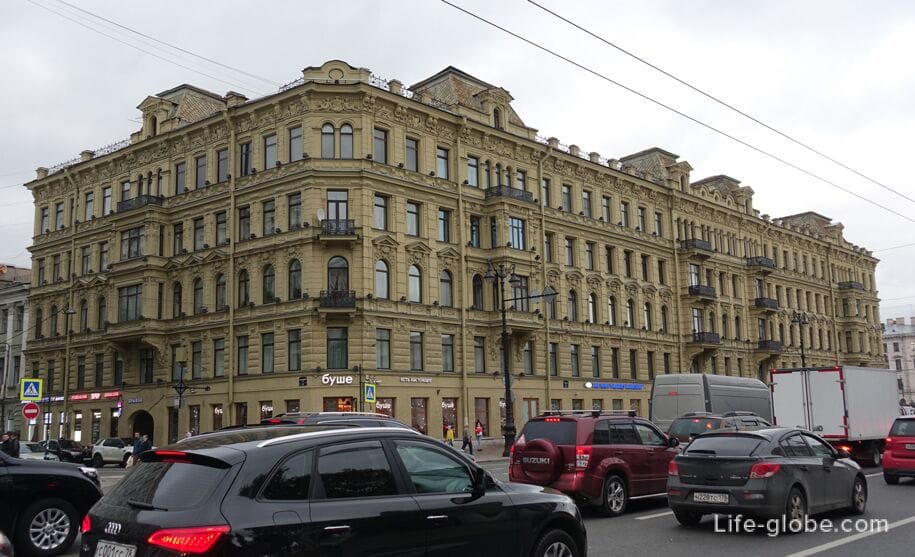
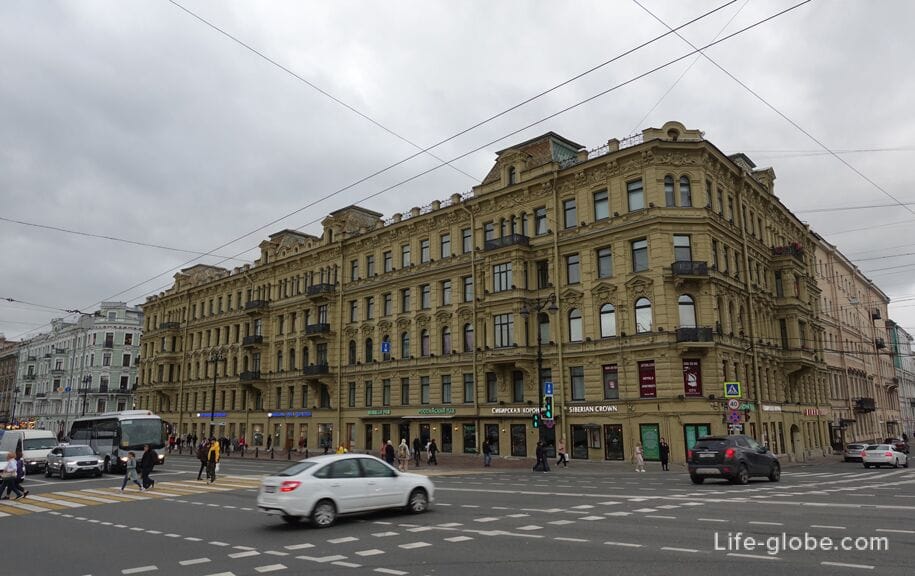
Anichkov Bridge
Anichkov Bridge is one of the most famous bridges in St. Petersburg.
The bridge is designed for the movement of vehicles and pedestrians. It runs through the Fontanka River and connects the Spassky and Bezymyanny Islands.
The first wooden bridge was built in 1712-1714 and was the first bridge over the Fontanka River, which at that time was called Erik or Unnamed Erik.
Subsequently, the bridge was rebuilt and strengthened several times.
The design of the Anichkov Bridge, which can be seen today, was born in 1841 according to the project of engineer Major Ivan Fedorovich Buttats. The project of the bridge was approved by Emperor Nicholas I.
Today, the Anichkov Bridge is a three-span structure in the form of three gentle arches, laid out of brick, on stone supports and faced with granite. A cast-iron fence of artistic casting is installed on the bridge.
The bridge is decorated with four recognizable sculptural compositions - "The Taming of the horse by man" or simply "The Taming of the Horse", which are installed on both sides of the bridge on granite monumental pedestals.
The composite art groups were created by the baron and sculptor Peter Karlovich Klodt and installed on the bridge in 1841-1850. Learn more about the Anichkov Bridge…
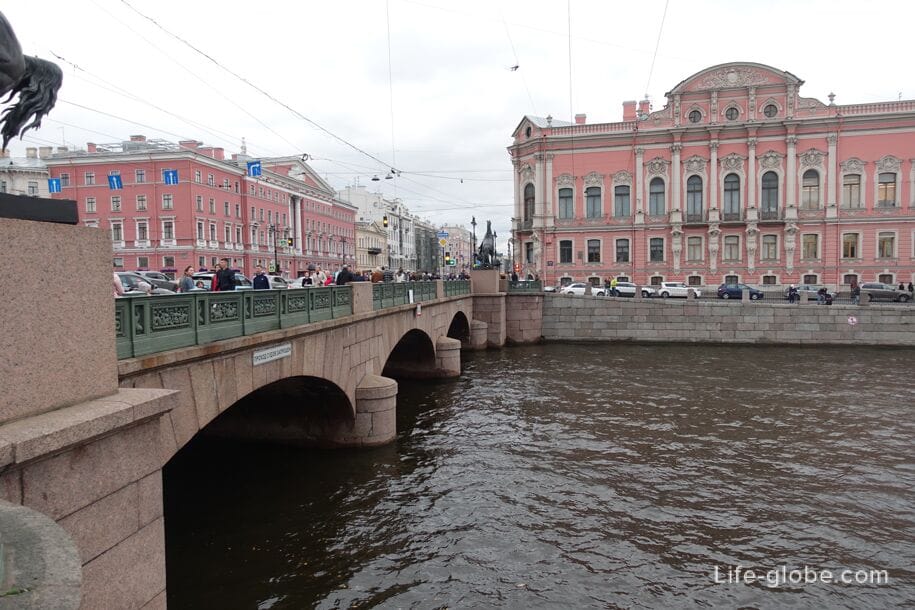
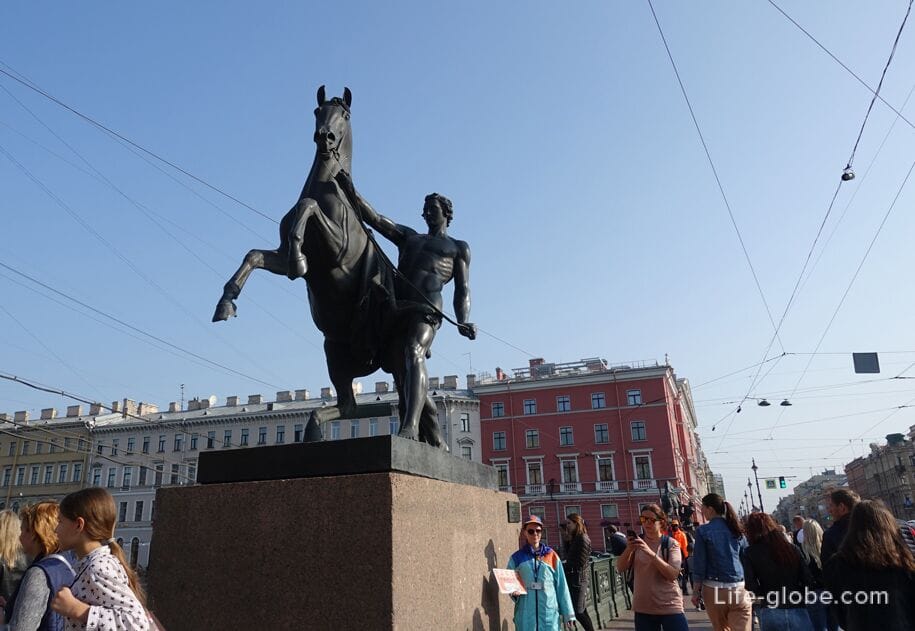
Beloselsky-Belozersky Palace (Nevsky Prospekt 41)
The Beloselsky-Belozersky Palace is a former mansion and a monument of architecture in the New Baroque style.
The palace was built in 1847-1848 by order of Prince Esper Alexandrovich Beloselsky-Belozersky.
Since 1884, the palace was owned by Grand Duke Sergei Alexandrovich-the younger brother of Alexander III. Hence the second name of the palace - "Sergievsky".
Subsequently, the palace changed owners and its interiors changed.
Today, the Beloselsky-Belozersky Palace attracts attention with its bright color, columns with capitals, architectural decorations of window openings and large figures at the ground floor level.
The palace is a place of culture - within its walls there is a museum, guided tours of the preserved interiors, as well as concerts, conferences, presentations and photo shoots. More about the Beloselsky-Belozersky Palace…
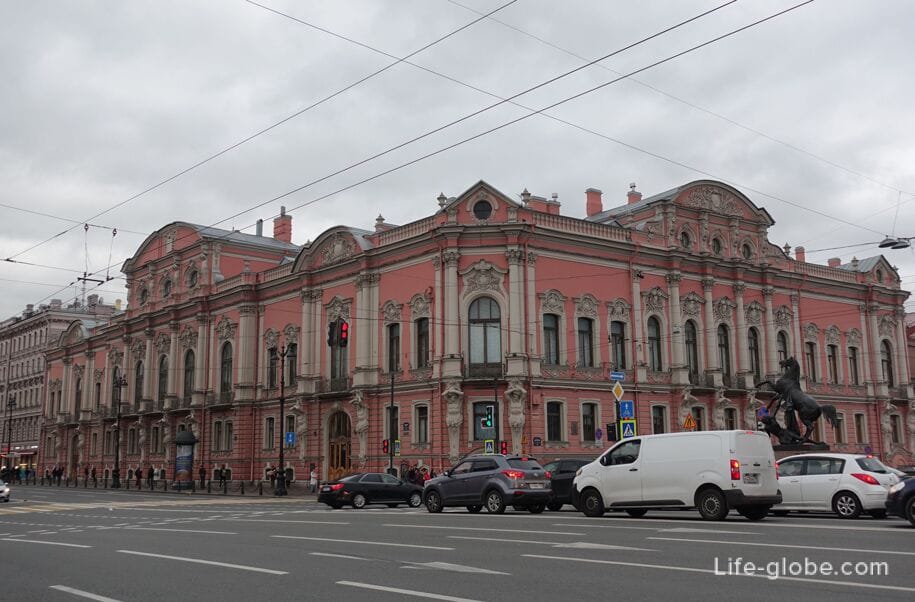
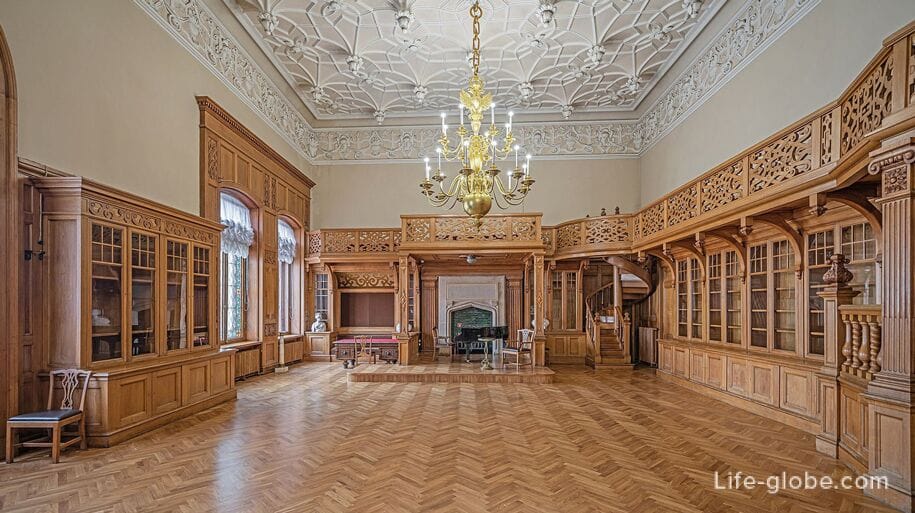
Literary House / house of Lopatin (Nevsky Prospekt 68)
The first stone buildings on this site appeared in the second half of the 18th century. At the beginning of the 19th century, there were two four-story buildings on the site of the current site.
Since the 1820s, the building passed to the merchant F. I. Lopatin, under whom in 1839-1840, according to the project of the architect Vasily Yegorovich Morgan, a four-story building was added along the Fontanka Embankment. After its construction, the building became one of the largest apartment buildings in the capital - apartments were rented out in it.
After that, the building changed owners. In the 19th century, the house was inhabited by famous writers of that time, which gave the building its second name - "Literary House".
During the Great Patriotic War, part of the building was destroyed. After the reconstruction.
In 2011, due to accidents, the building was demolished, and then (2015) recreated with the addition of one floor and a repeat of the Soviet facade of the mid-20th century.
Today, the building houses commercial premises and houses organizations.
In the house you can stay: apartment "Fontanka 40" with three bedrooms, free Wi-Fi and parking; apartment Letyourflat Apartments "Fontanka" with free Wi-Fi, parking and room service; Apartment Apartments Nevsky 68 with garden views and free Wi-Fi.
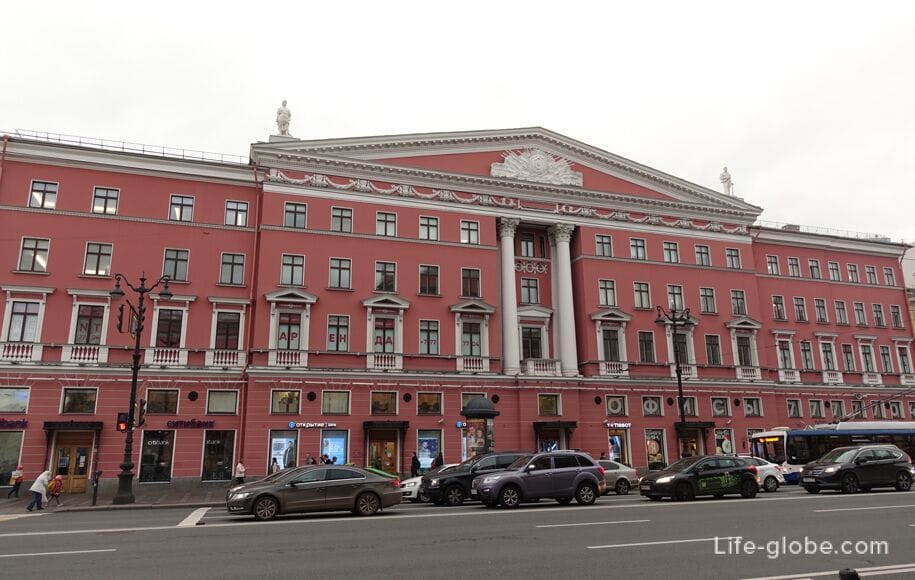
This section ends the most refined and visited part of Nevsky Prospekt with numerous attractions, including churches, palaces and three bridges running along the axis of the avenue.
Since Nevsky Prospekt is large and has many interesting objects, for the convenience of readers, the description of the avenue is divided into three separate articles:
1. This article.
2. The second part, which describes Nevsky Prospekt from the Beloselsky-Belozersky Palace and the Literary House to the Vosstaniya Square inclusive. The so-called front part of the avenue ends at Vosstaniya Square. Learn more about the second part of Nevsky Prospekt…
3. Description of Nevsky Prospekt from Vosstaniya Square to the end of the avenue - Alexander Nevsky Square and Holy Trinity Alexander Nevsky Lavra. This part of the avenue is unofficially called "Staro-Nevsky Prospekt". Learn more about the third part of Nevsky Prospekt...
Practical information
Metro stations on Nevsky Prospekt and near the avenue: "Admiralteiskaya", "Nevsky Prospekt", "Gostiny Dvor", "Mayakovskaya", "Ploshchad Vosstaniya" and "Alexander Nevsky Square".
Public buses and trolleybuses run along Nevsky Prospekt and near the avenue.
You can visit Nevsky Prospekt either on your own or with one of the city tours
All accommodation facilities in St. Petersburg, including in the city center and on Nevsky Prospekt, can be viewed and booked here




